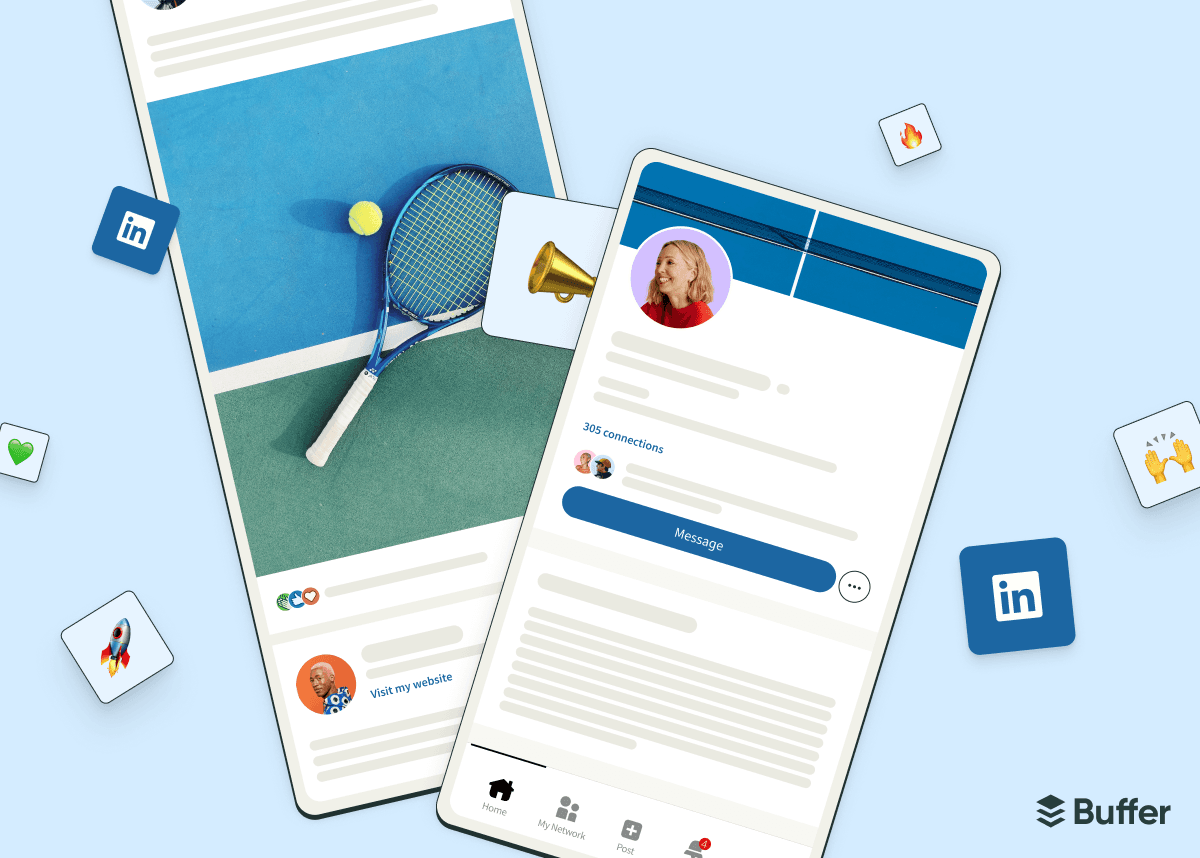LinkedIn used to be the place you'd dust off your resume and hunt for your next job. Today, that’s just a sliver of how people are using the social platform.
A quick scroll now throws up founders building in public, creators sharing their wins, and hot takes on everything from positioning to pricing to — of course — AI.
And while businesses are still hiring on LinkedIn, many are also pulling back the curtain to show what life inside their company really looks like.
This evolution has opened up serious opportunities for both brands and creators. With over 1 billion users, LinkedIn has grown into a place where B2B professionals, creators, and businesses alike can grow their presence, find new opportunities, and connect with people who care about their work.
In this guide, I’ll cover:
- why LinkedIn has become the platform for B2B creators and businesses
- how both businesses and creators can use LinkedIn effectively
- what content actually gets engagement on the platform, and
- six practical steps to build your LinkedIn marketing strategy.
Ready? Let’s begin.
What is LinkedIn marketing?
LinkedIn marketing is the practice of using LinkedIn to build your brand, cultivate relationships with potential customers or collaborators, attract talent, and create opportunities for your business or career.
The platform gives both creators and businesses plenty of tools to make this happen.
If you're a creator, you can set up a profile that showcases your expertise, share posts that get people talking, start a newsletter to build a regular audience, and publish longer-form articles when you have something more in-depth to say.
Businesses can do the same through posts, newsletters, and articles — plus other tools specifically for brands, like company pages, events, ads, and job listings.
Is LinkedIn marketing right for your business or brand?
LinkedIn calls itself “the world's largest professional network on the internet,” and this captures why it feels different from every other social network: It’s more than another feed to scroll through.
LinkedIn is where people go to talk shop, share ideas with others in their field, and build relationships that move their careers or businesses forward.
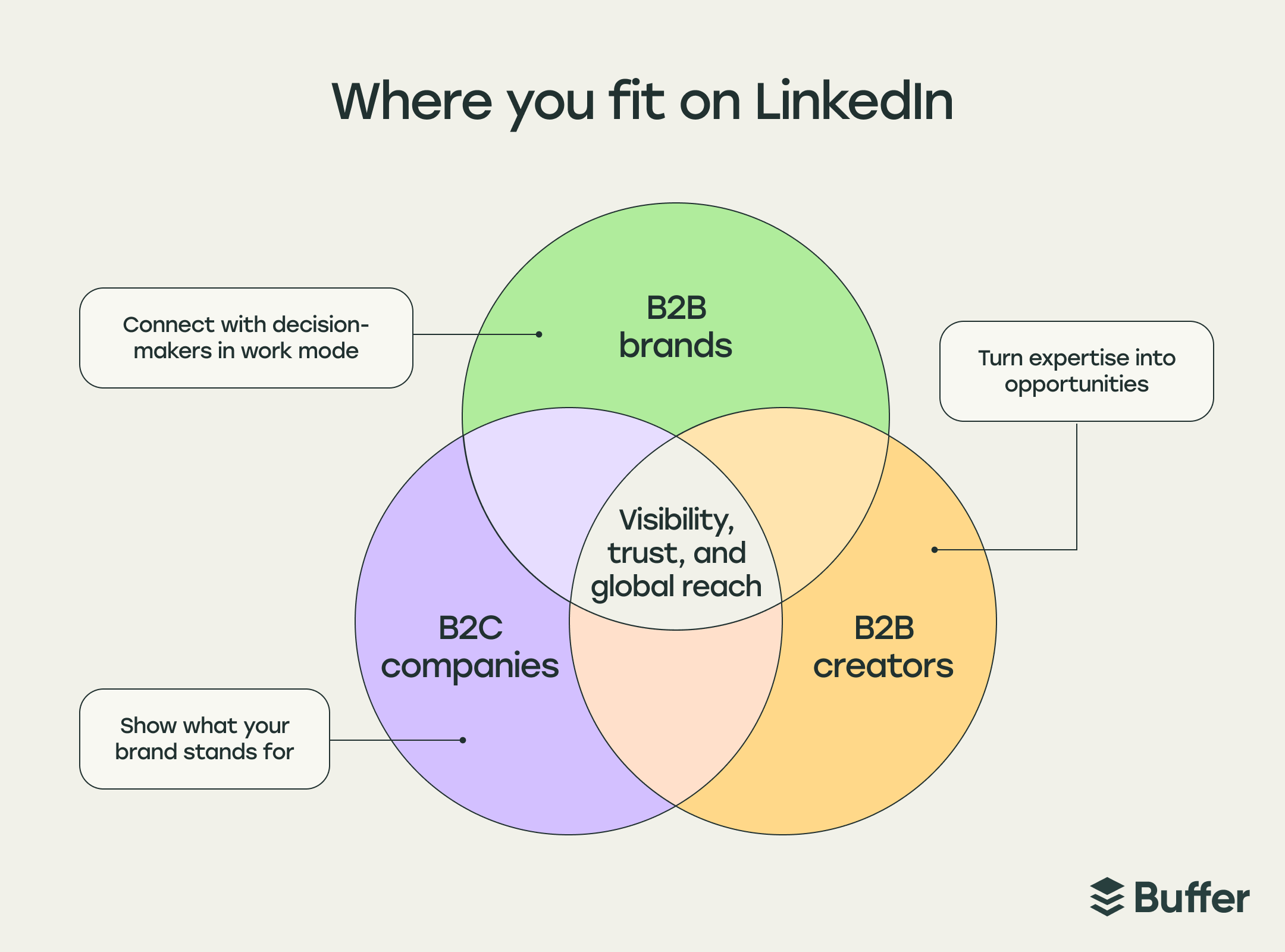
B2B brands
LinkedIn is where most of the B2B players are already paying attention. In a 2025 global survey from Social Media Examiner, 87% of B2B marketers said they use LinkedIn for marketing, and more than half said it’s the single most important social platform for their business.
If you're selling to other businesses, LinkedIn puts you in front of decision-makers when they're already in a professional mindset.
B2C companies
LinkedIn hasn’t been the go-to platform for B2C brands in the past, but that’s changing. More consumer brands today are using LinkedIn as a brand awareness channel to share what they stand for and stay visible.
It’s not the strongest channel for direct consumer sales — unless your target audience is professionals, or your product fits into how they work — but it is becoming a powerful place to attract talent, highlight partnerships or find new ones, and show your impact to potential collaborators or investors.
B2B creators
For creators who work in B2B industries, LinkedIn can be the launchpad for new opportunities. By sharing your expertise on the platform, you open doors to prospective clients, recruiters, collaborations, and speaking opportunities that might never have found you otherwise.
And because LinkedIn is global, your networking opportunities with brands, peers, and industry leaders extend far beyond your local circle.
Sophie Miller, founder of Pretty Little Marketing, sees LinkedIn becoming a big stage for B2B creators. “We're about to see B2B creators absolutely explode on LinkedIn in ways we haven't seen before!” says Sophie. “Brands are finally realizing that people connect with people, not logos.”
Getting started with LinkedIn marketing
If LinkedIn is where you’d like to build your personal brand or business, you’ll need the right kind of presence. Businesses can set up a LinkedIn Company Page, while creators start with a personal profile.
Let’s take a closer look at both.
Company Pages for businesses
A LinkedIn Company Page acts as your brand’s headquarters on the platform.
Every post, comment, and reaction from a company page is on behalf of the business — not an individual — which means the voice and values you share reflect your brand as a whole.
With 40% of users engaging with a LinkedIn Page every week, keeping yours active is a great way to help your brand stay visible and relevant. If someone wants to know what your business does, what your workplace is really like, who works at your company, and what principles drive your decisions, your company page is where they’ll go to get these details.
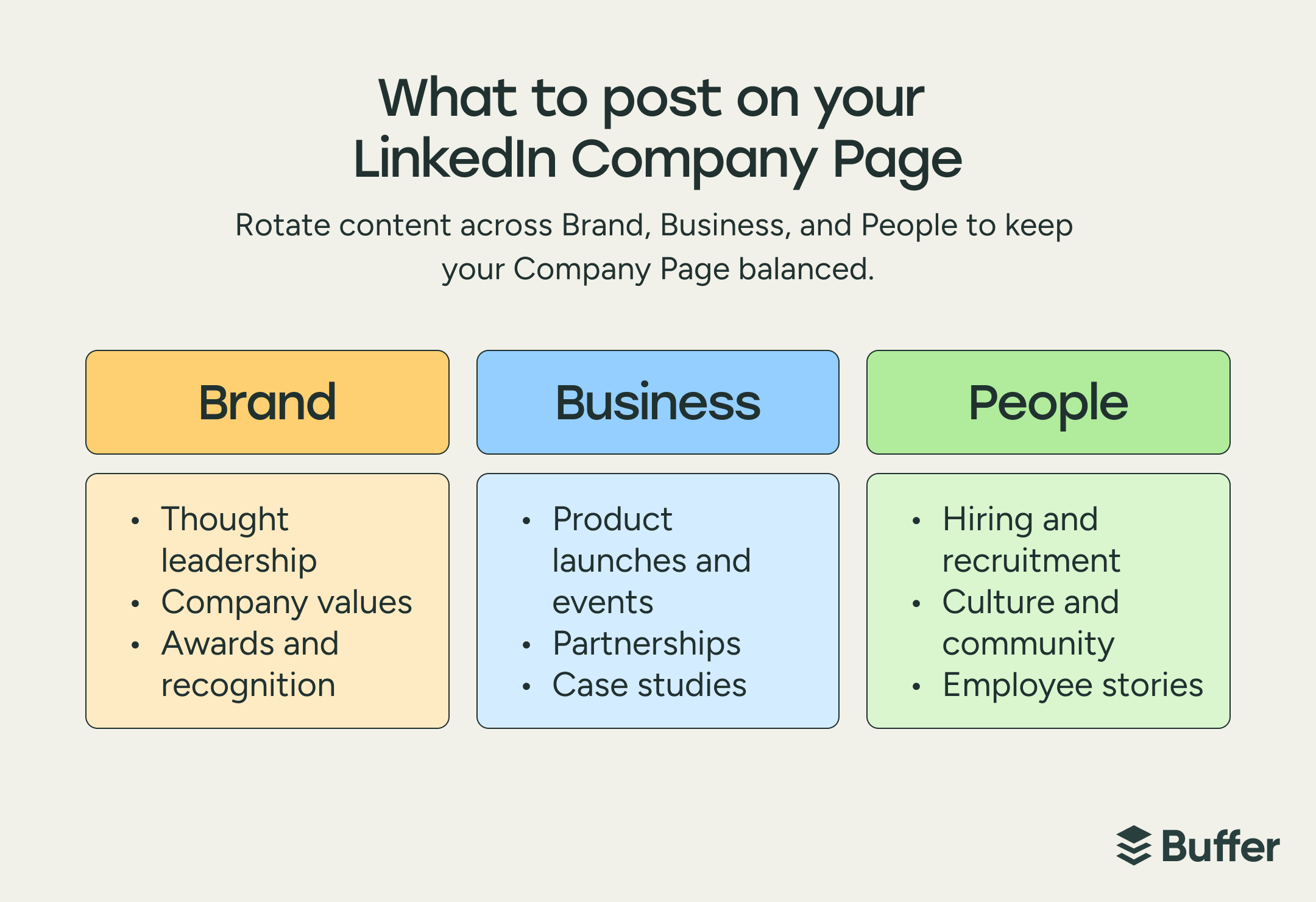
How to optimize your LinkedIn Company Page
It’s worth it to take the time to get your LinkedIn Page set up right. A complete, well-optimized LinkedIn presence allows your target audience to easily find you on and off LinkedIn (meaning on search engines like Google).
This should be your first port of call when it comes to LinkedIn best practices.
1. Add a clear profile picture and cover image
Use your logo as the profile picture so visitors can connect the dots between your LinkedIn presence and your business website, store signage, other social media accounts, or anywhere else they can find you.
The cover image gives you more flexibility — it could show your team, your product, campaign artwork, event photo, or something else that reflects what your company does.
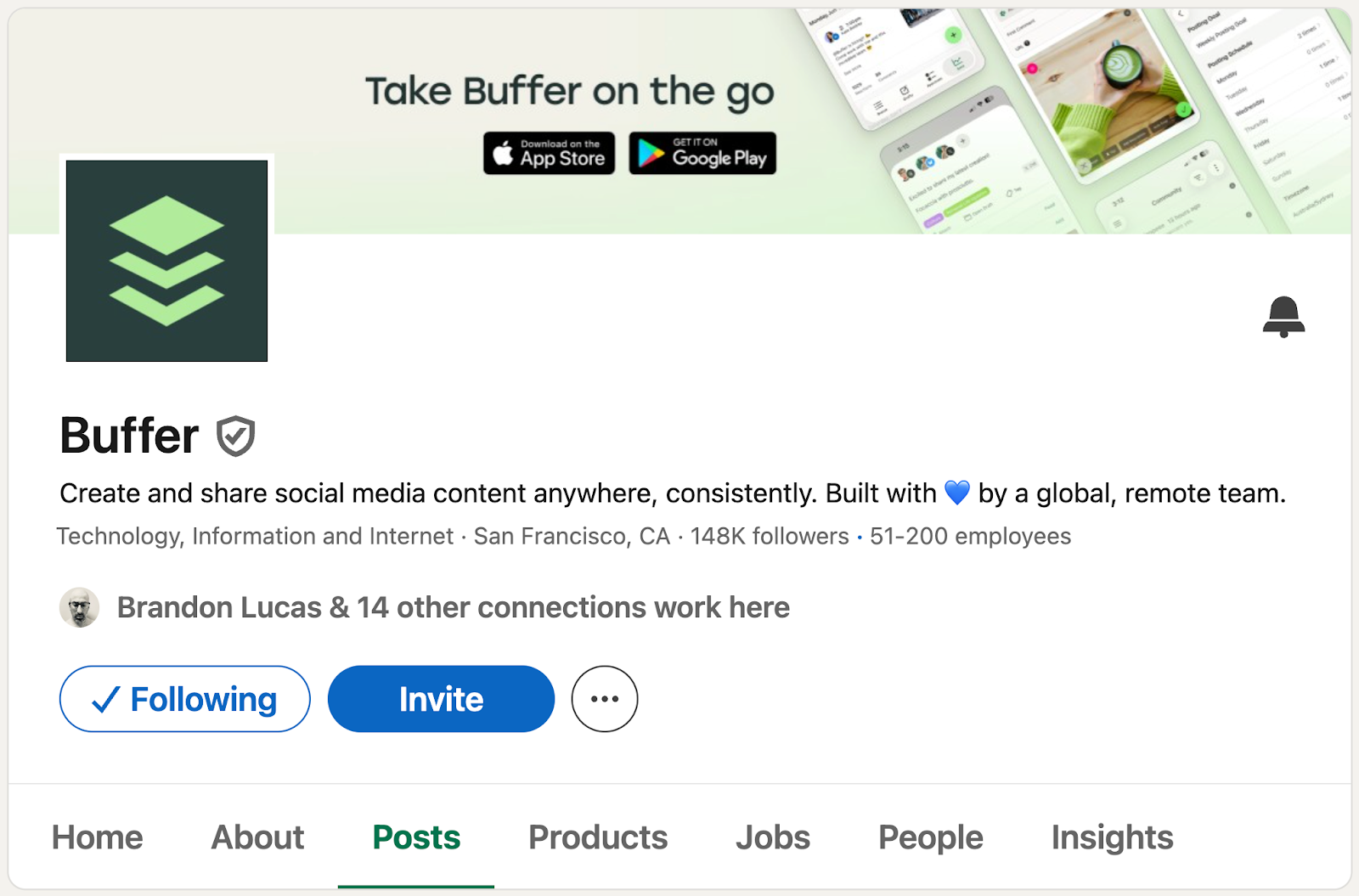
2. Complete your business information
LinkedIn requires you to fill in some parts of your company page — like the overview, industry, and company size — before the page can go live. Others, like your tagline, services, specialties, and contact details are optional, and filling them in gives visitors extra ways to understand what you do.
LinkedIn Pages with complete information get 30% more weekly views, so filling out every section helps more potential customers, partners, or future employees discover your business.
3. Use SEO keywords
LinkedIn also recommends using search phrases and keywords in your page to help people find you. This practice, known as LinkedIn SEO (search engine optimization), helps your page rank higher in search results on the platform.
There are two places on your LinkedIn Page where you can insert keywords: your company description and specialties. You can find these by navigating to your Company Page > Edit Page > Details.
Pro tip: Add a link to your LinkedIn Page from your website. LinkedIn calls this “an easy win” to help boost search ranking on the platform. On the Buffer website, we link to all our social media profiles, including our LinkedIn Company Page.

4. Set up call-to-action (CTA) buttons and forms
You can customize your page with CTAs that invite users to take the next step. LinkedIn offers different options to fit different goals.
- Invite allows people to invite their connections to follow your page.
- Message lets people send you a DM on the platform.
- Visit website, Visit portfolio, Sign up, Register, Visit More, Contact us, and Learn more all let you send people to a URL of your choice.
You can also add a form to collect leads directly from your LinkedIn Page for a sale, demo, free trial, or to get started with your product or service.
5. Share your company’s hiring policies
If you use LinkedIn for recruitment, the Workplace module and Commitments section can help future employees understand what it’s like to work at your company.
The Workplace module highlights where and how your team works — on-site, hybrid, or fully remote — along with the benefits that support each setup.
The Commitments section focuses on what your company values most, like career growth, learning opportunities, sustainability, or work-life balance, and the perks that go with them.
Personal profiles for creators
A LinkedIn personal profile acts as your professional identity, showing your experience, achievements, and what you post.
For Callie Schweitzer, Head of Premium Content and Community Strategy at LinkedIn, personal branding starts here. “You have full control over that on your LinkedIn profile and how you really want to show up authentically,” she says.
Your LinkedIn profile is also where new opportunities start, from recruiters reaching out to clients discovering your work. For some creators, having an active LinkedIn presence can even lead to unexpected opportunities beyond the platform.
“One thing that’s been surprising is how much LinkedIn has opened doors outside of LinkedIn,” says Tami Oladipo, Senior Content Writer at Buffer.
“My posts there have led to speaking gigs, podcast invites, and brand partnerships — not (always) because I was chasing those things directly, but because showing up consistently made me discoverable.”
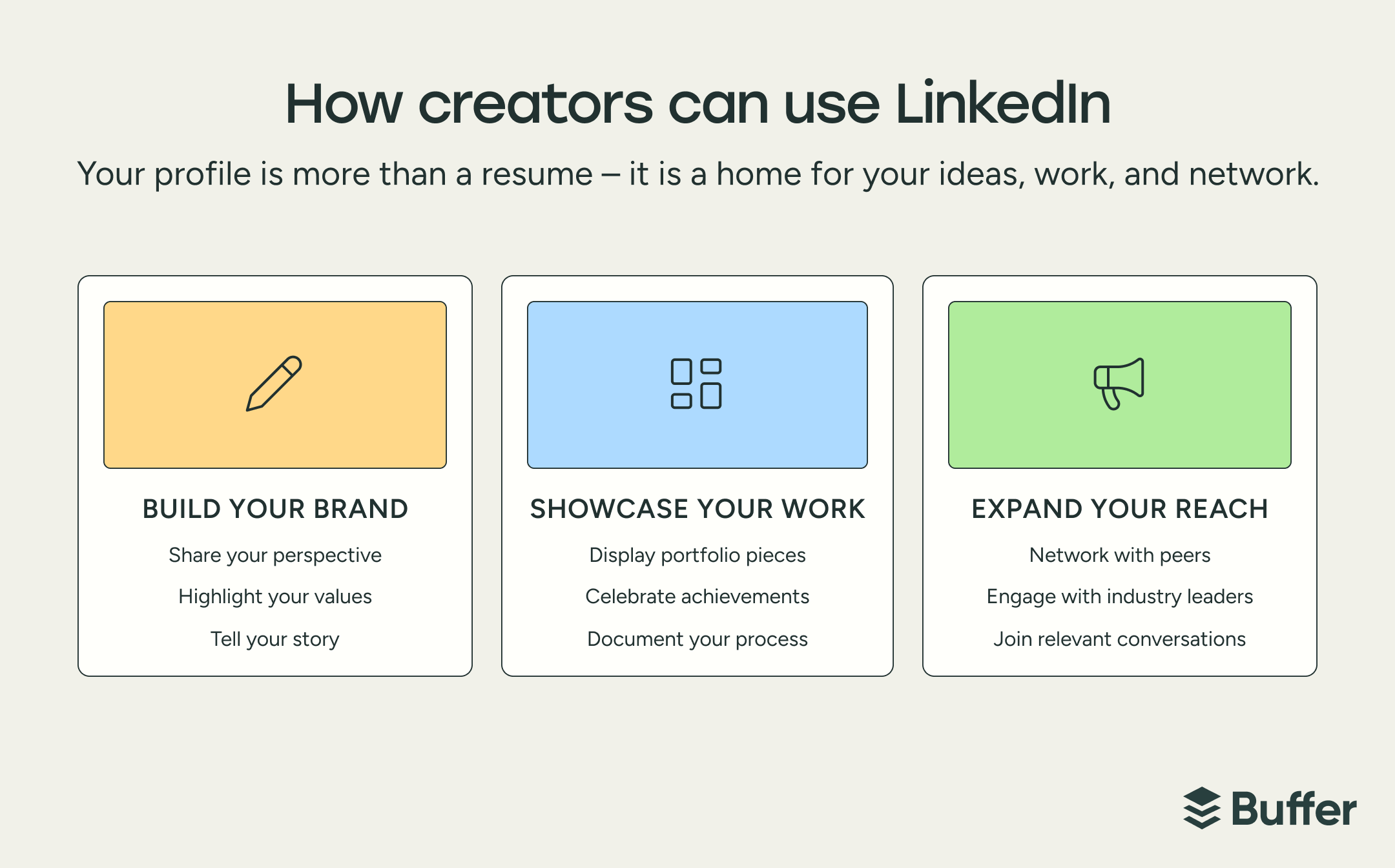
I asked creators on LinkedIn why they post, and three themes stood out: building a personal brand, networking and community, and marketing their business or services.
Having a strong profile is where all of that begins.
How to optimize your LinkedIn profile
Your profile is often the first place people look before they reach out. “Whether it’s thinking about a hiring manager or a brand manager looking at your profile, that’s your digital resume, that’s where people are going,” says Callie.
Staying optimized also means you’ll show up in more searches and make it easier for LinkedIn users to find you.

Here’s what LinkedIn recommends people do.
- Build out every section of your profile and continue to optimize it regularly.
- Update your profile with new projects, skills, and milestones so it reflects what you’re doing right now.
- Let your personality come through alongside your experience.
1. Use a standout profile image, banner, and headline
First impressions on LinkedIn start with your photos and headline.
A clear, high-quality headshot is always a good place to start for your profile photo. Some industries — like finance or law — often expect a photo on the formal end of the spectrum. If you work in a creative or laid-back field, you have more room to be relaxed and show more of your personality. Either way, choose a photo that represents how you show up at work.
Your banner is another chance to show personality and context. It could feature your work, contact details, a snapshot of you speaking at an event, or a short line that sums up what you do — there’s plenty of room to get creative.
Freelance writer Stephanie Trovato uses hers for social proof, showcasing client logos to highlight who she’s worked with.
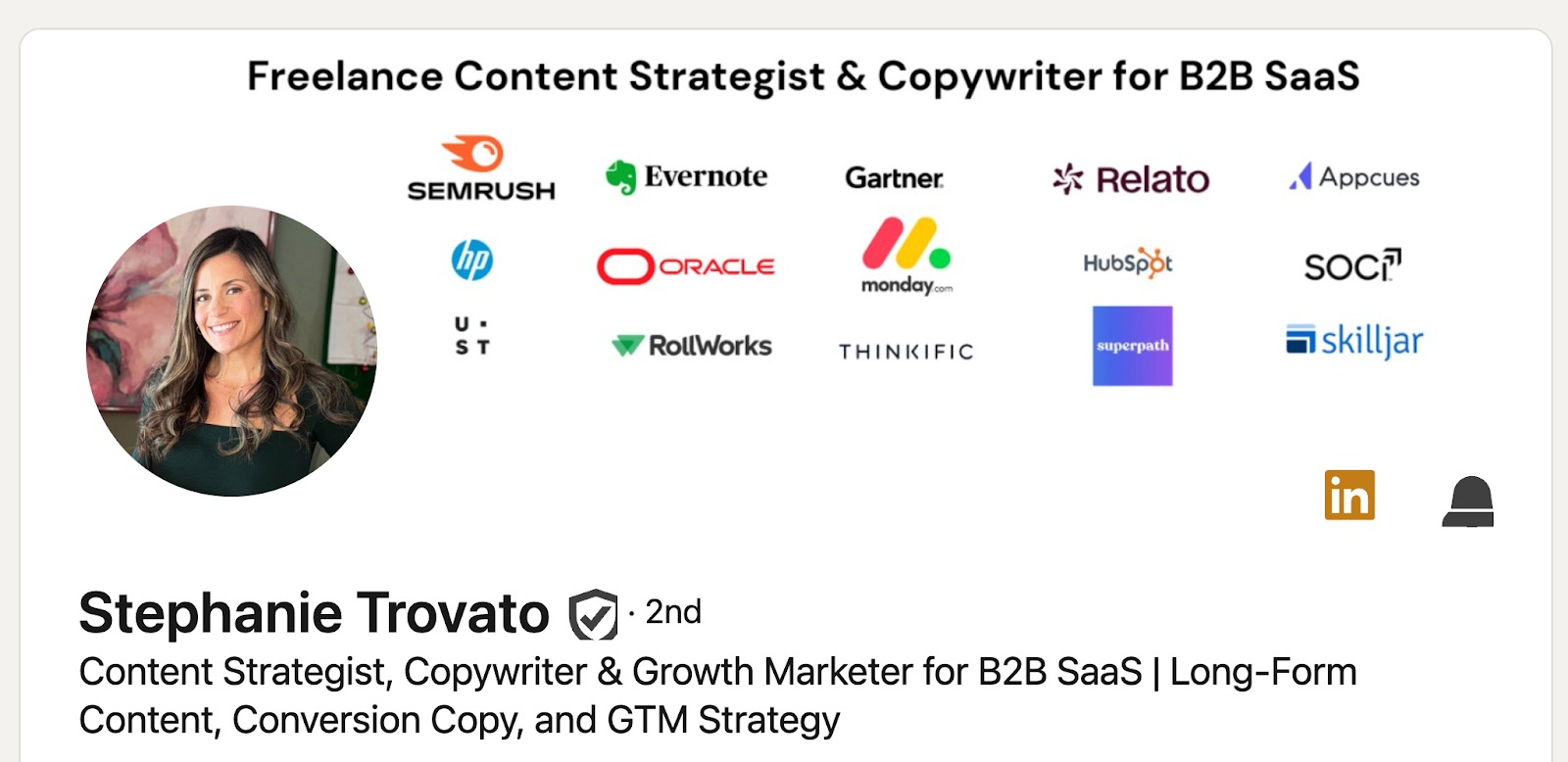
Your headline tells people what you do, who you help, and the skills you bring. It also follows you on LinkedIn, appearing below your name when someone sees a post or comment. Laura Lorenzetti, Senior Director and Executive Editor at LinkedIn News, says this is one part of your profile you should really pay attention to.
“If people don’t know you, they’ll look at your name and headline, and they’ll match that to what you’re saying,” says Laura. “They’re trying to understand your credibility and expertise, so the more thoughtful you are of how that headline reflects that credibility and expertise and what you want to speak to the better.”
You’ve got 220 characters to work with, so make them count. Laura recommends being descriptive about your value and expertise — instead of just listing your title — to give people context that makes them trust you.
You should also try to include keywords people may search for when they’re looking for someone with your skills or experience.
2. Add keywords to your profile
Your headline, job title, About section, and even your LinkedIn URL are all searchable. Using the right keywords — whether it’s your specialty, industry, or target clients — gives your profile a better chance to show up in search results.
Freelance designer Franziska Böttcher nails this: her headline and About section both feature high-impact keywords that make her easier to discover.


⚡ Pro tip: To change your URL, visit https://www.linkedin.com/public-profile/settings and then click on Edit your custom URL on the right. Remember to update it wherever it’s saved, such as your website, resume, or other social media.
3. Share your best work
The Featured section is prime space to spotlight the wins, moments, and projects that make up your professional highlights. Think of it as a curated mini-portfolio: new visitors see your achievements right up top, without having to dig.
Here’s what you can add to the Featured section:
- Published LinkedIn posts, newsletters, or articles
- Links to any URL off LinkedIn, like a landing page, blog post you wrote, or article that featured you
- Media including images, graphics, and PDFs
There’s no hard limit for what you can add here, but less is more. This is your greatest hits, not the whole back catalog.
4. Add important details to your Experience section
The Experience section of your LinkedIn profile is your online resume that people scan to get a sense of your work history and experiences. Treat it like a real resume — instead of focusing on responsibilities, show the impact you’ve had in different roles.
Keywords belong here, too. Add them to job titles, skills, tools, and industry terms to help your profile show up in more searches and make it clearer how your background fits what people are looking for.
5. Showcase licenses and certifications
The certifications you’ve earned add weight to your profile and show that you’ve invested in your skills. You can add any formal credentials and specialized training to the Licenses and Certifications section on your LinkedIn profile.
You can also add supporting media if you’d like to share the work you created as part of that certification, like a website you built, a final project, or a video presentation.
Plus, many programs let you link directly to an online certificate, which helps others verify your achievement.
⚡Pro tip: Keep an eye on expiration dates. Some certifications need to be renewed, so review your profile periodically to remove expired credentials or retake the exam to keep them current.
What are the best performing content formats on LinkedIn?
LinkedIn offers you many ways to get your message out there, whether you’re posting from a Page as a business or your profile as a creator.
Text posts work well when you want to share a quick update or tell a longer story. Images and graphics catch someone’s eye as they scroll. Videos let people see your face and hear your voice, which helps build a connection.
So how do you choose the right format for your audience? “It’s all about experimenting,” says Callie Schweitzer. “The perfect balance of a LinkedIn presence is a mix of formats and what your audience wants to see.”
Let’s look at the options available.
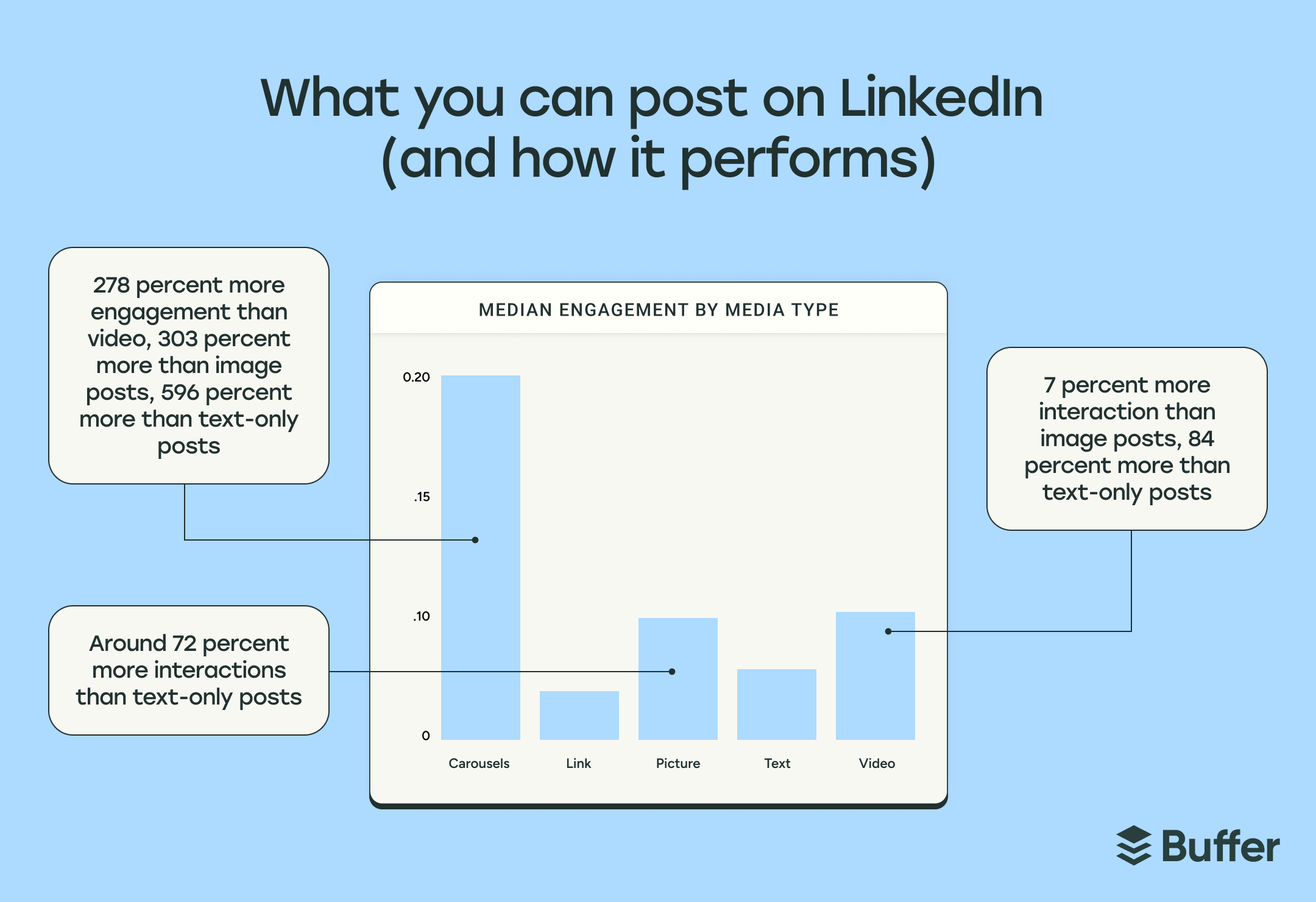
Carousels
Carousels consistently rank among the top-performing post types on LinkedIn. Buffer’s data shows that they get a massive 278% more engagement than video posts, 303% more than image posts, and 596% more than text-only posts.
Carousels invite people to stop, swipe, and spend more time with your LinkedIn content. They’re visual, meaning they catch the eye as users scroll, and they’re flexible. You can use them to:
- Turn a long post into bite-sized slides
- Highlight key takeaways from an article or report
- Walk through a tutorial or step-by-step guide
- Showcase before-and-after results or client projects
Pretty Little Marketer regularly uses carousels to make it easier for people to digest how social media works.
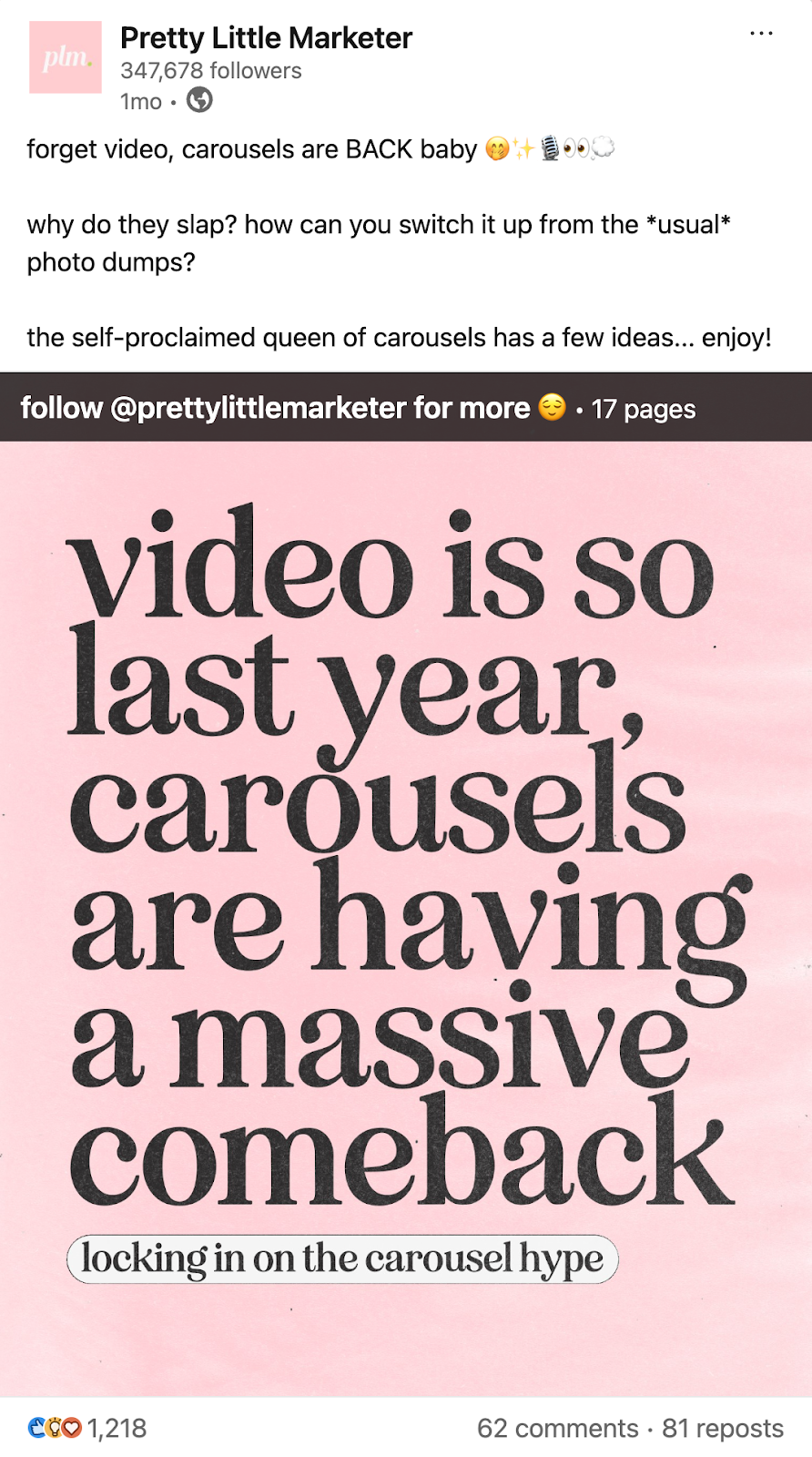
If you’re looking for more ideas and examples of how to put carousels to work, this guide walks through 11 different ways to use them.
Video
Video takes the second spot for engagement on LinkedIn. Video posts earn 7% more interaction than image posts and 84% more than text-only posts — and the format is still gaining momentum.
Lakshman Somasundaram, Senior Director of Product at LinkedIn, shared that video is growing 1.6x faster than all other types of content combined. Creators who use video see up to 3x growth in followers, which means more visibility and more opportunities to build personal connections.
There are two main kinds of videos on LinkedIn: short-form and LinkedIn Live.
Short-form video
Short-form videos are designed to grab attention quickly and deliver value fast. LinkedIn recommends keeping them concise at around 60 to 90 seconds. That gives you enough time to deliver something useful without losing someone’s attention.
Brands can use short-form videos to share snippets from longer content like podcast episodes, demo new features, walk through tutorials, or showcase video testimonials from customers.
For creators, it’s also a chance to make content that feels personal and relatable. Kirsti Lang, Senior Content Writer at Buffer, regularly shares videos about remote work and life at Buffer that give people a behind-the-scenes look at her professional life.
Lakshman shared a few quick tips to help short-form videos perform better.
- Open with a short on-screen text hook that tells people what they’re about to watch — something that grabs attention in the first second or two.
- Add captions so that people who are watching on mute can follow along instead of scrolling past. Eighty-five percent of LinkedIn videos are viewed without sound, so captions can make a big difference.
- Use visual and audio elements like sound effects, B-roll, and graphics to keep the video dynamic.
LinkedIn Live
LinkedIn Live allows you to broadcast in real time to your followers and network. These sessions are public and automatically saved to your profile or Page once the stream ends, so people can rewatch them later.
Live video tends to get a lot more people reacting and commenting than short-form video — 7x more reactions and 24x more comments. They’re ideal for product launches, Q&As, panels, fireside chats, and other moments where real-time interaction adds value.
To go live on LinkedIn, you’ll need:
- A profile or page with at least 150 followers or connections.
- A record of following LinkedIn’s Professional Community Policies.
- An account or page that’s at least 30 days old.
Images
Image posts come in third for LinkedIn engagement — they get about 72% more interactions than text-only posts. Posts with images see twice as many comments, so if you're looking to start conversations, images can help get that going.
Both businesses and creators can use images to bring work to life: product photos, behind-the-scenes moments, announcements, or previews of what’s coming next.
The Women in Tech SEO community often shares screenshots from its newsletter to highlight articles written by its members. It’s a simple way to give non-subscribers a peek at the kind of content they’ll find inside while celebrating the voices within its community.
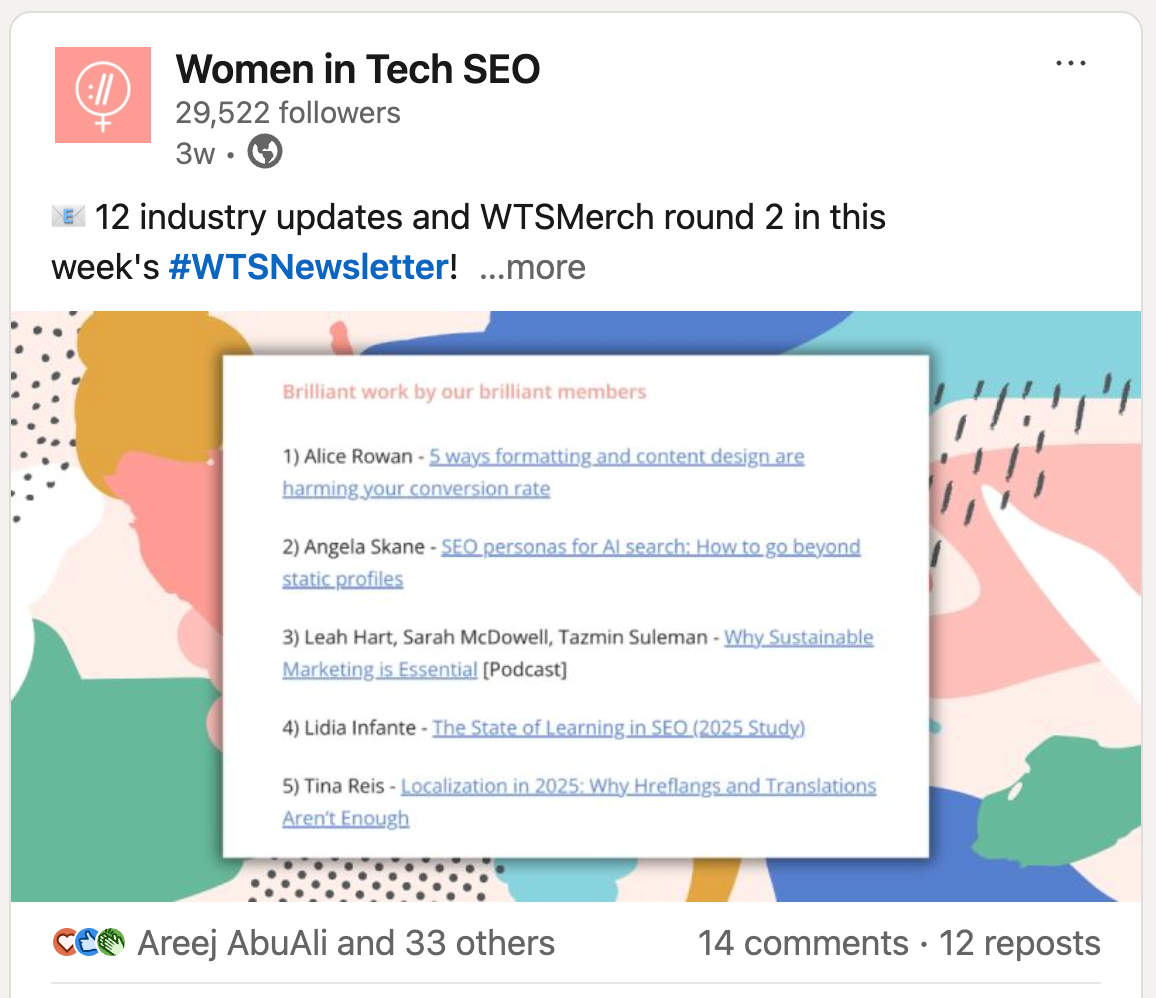
For creators, those behind-the-scenes glimpses can include everyday life as well as work, helping followers see the person behind the posts.
To keep your visuals looking their best, use LinkedIn’s recommended image sizes: between 1080 x 1350 pixels (vertical image) and 1080 x 360 pixels (horizontal image). If your text or main visual is centered, most sizes will display without awkward cropping.
Text posts
Text posts work well for almost any kind of idea you want to share on LinkedIn. They can be short and conversational — a quick thought, lesson, or question for your audience — or dive deeper into something you’ve been reflecting on.
If you have something you’d like to go really in-depth into, you can always expand a post into a full LinkedIn article.
They’re a good fit for sharing career tips, personal reflections, or lessons from your work. You can also use them to weigh in on industry news, walk people through your process, or share moments from your day-to-day that others might relate to.
Text posts are my go-to LinkedIn content format as a creator. The things I post about — freelancing, content creation, and the processes that make both easier — lend themselves to stories, and writing is still the best way I know to tell them.
LinkedIn newsletters
Newsletters are LinkedIn’s way of letting you share long-form content with an audience that subscribes to hear from you. Subscribers get in-app and email notifications about each new edition, helping you stay top of mind while building credibility and trust over time.
Newsletters can also work beyond LinkedIn — they show up in Google search results, giving you another opportunity to use SEO keywords to get noticed.
If you write long-form content on other platforms — say your company blog or creator Substack — newsletters give you a way to share it with your LinkedIn audience without doubling your workload. You can simply repurpose what you’ve already written and link back to the original source to bring people over.
Any creator can start a LinkedIn newsletter, but businesses need to meet a few requirements before they can publish through their page:
- Have more than 150 followers
- A track record of creating original content on LinkedIn, like posts, videos, or articles
- A page and admin (person managing the page) in good standing with LinkedIn’s community policies
You can have up to five LinkedIn newsletters. Buffer currently runs two. Bottom Line is a monthly look at the company’s key financial metrics and trends, and Open Blog shares lessons from trying new approaches to work, growth, and company culture.
Polls
Polls are a simple way to learn from your audience. They take only a couple of minutes to set up and can reveal what your community’s interested in or needs help with.
You can ask people what topics they want to hear more about, which format they prefer for content, or what challenges they’re dealing with right now. The answers can shape what products you build, what blog posts you write, or what you talk about in your next video.
They’re also a low-lift way to encourage engagement. Staffing and recruiting company Hays got nearly 6,000 votes and 50 comments on their poll asking about the role of soft skills in landing a job.

What are the different types of content to post on LinkedIn?
Once your profile or Page is ready, it’s time to start sharing. LinkedIn content helps brands and creators build authority, form authentic connections, and open doors for new customers or partnerships.
Here’s something worth knowing as you think about what to post: LinkedIn doesn’t reward virality, it rewards value. So if you’ve noticed older posts resurfacing in your feed weeks later, that’s intentional.
Gyanda Sachdeva, LinkedIn’s VP of Product Management, explained to Business Insider that they’ve adjusted the algorithm to prioritize relevance.
“Our goal is to strike that balance of always showing you the most relevant updates from your network and from the people who can help you grow,” Gyanda says, “even if we have to tweak the recency algorithm every now and then.”
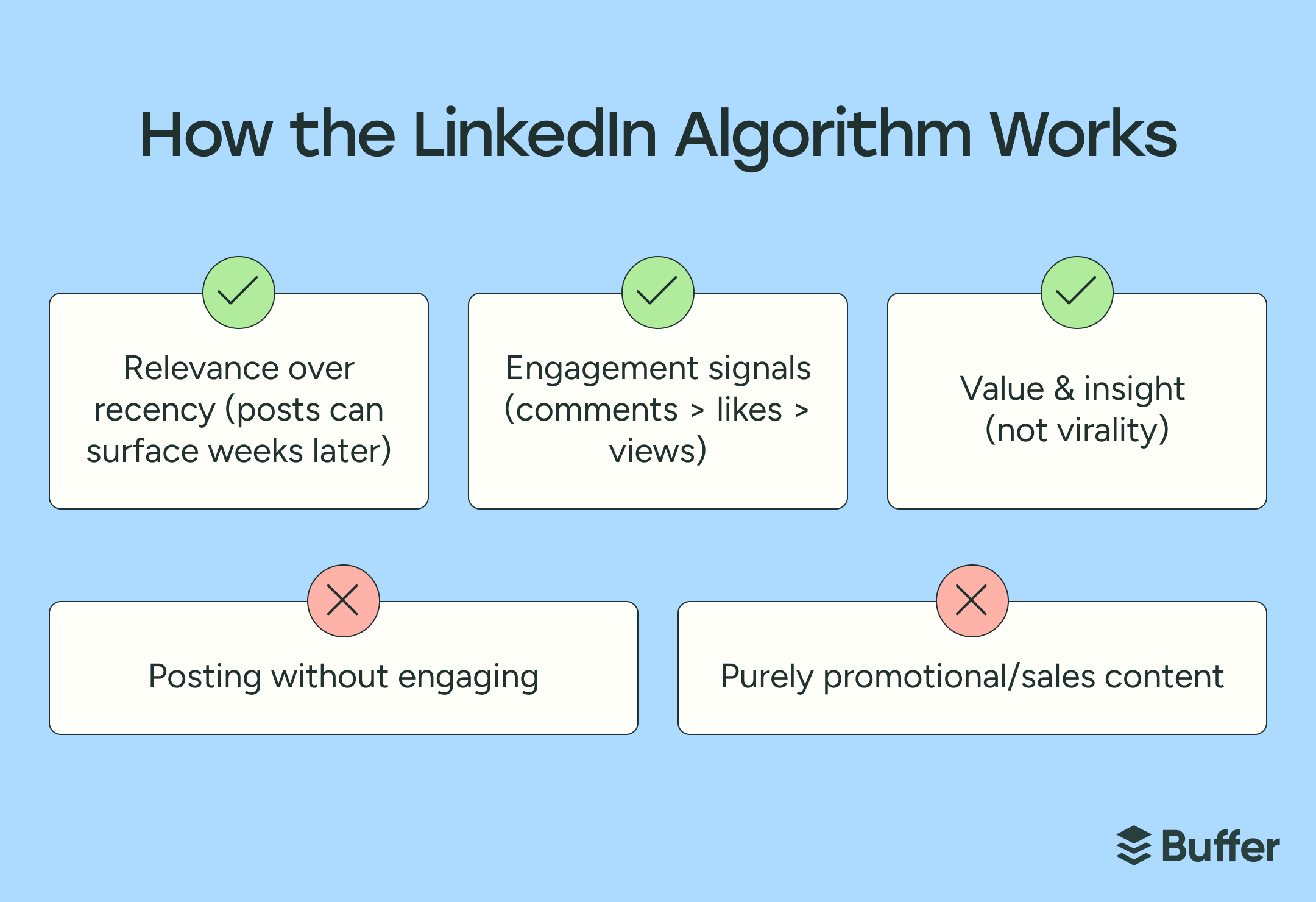
What does that mean for businesses and creators? Focus on creating content that teaches, informs, or inspires — something that offers a clear takeaway. “When planning your content, always share a key insight or a key takeaway,” says Callie Schweitzer. “Think about what that value add is for your audience, because that’s what people are expecting on LinkedIn.”
Rishi Jobanputra, Senior Director of Product Management at LinkedIn, shared a few types of content that perform especially well on the platform.
- Insights: Share your experience or perspective. Posts that show how you think, not just what you know, help your audience see your expertise in action.
- News: Talk about what’s happening in your industry, and explain why it matters. Adding your context turns it from a news bulletin to a unique point of view.
- Day in the life: Offer a behind-the-scenes look at your work — what a typical day involves, what tools you rely on, or what problems you’re solving.
Let’s dig into these and more.
Thought leadership
Scroll through LinkedIn for a bit and you’ll see people share their take on a trend, weigh in on a news story, or explain how they approach challenges at work. That’s thought leadership, and it tends to get noticed, earning 6x more engagement than job posts.
Its value also goes deeper than likes or comments. According to Edelman, 73% of decision-makers say they trust an organization’s thought leadership content more than its marketing materials when they’re trying to understand if the company can solve their problem.
And more than 75% said that a single thought leadership content led them to explore a product or service they hadn’t considered before.
Sharing what you know — and how you think — can open doors that pure promotion can’t.
LinkedIn has also been pretty direct about what works on the platform. “While it can be tempting to sell your audience on the benefits of your product or service, ‘salesy’ content doesn’t generally perform well on LinkedIn,” the company notes. “If there’s one thing LinkedIn members find engaging, it’s a fresh idea.”
Educational content
Educational content on LinkedIn is the how-to guides, the tips, the problem-solving posts that give people clear, practical takeaways they can apply right away.
If you’re a business, this is the perfect kind of content to show people how to achieve something using your product.
Glide, a no-code app building platform, shares tutorials that show how to do specific things in the app. But here’s where they do something interesting — they don’t just post their own tutorials. They also share videos created by experts in their community, which gives people an outside perspective on how to make the most of the tool without it feeling like a sales pitch.
For creators, this kind of content can show your process in action. Walk people through how you do something — oversee a project, organize your workflow, use a specific tool — instead of how to do it.
AMAs (Ask Me Anything)
AMAs are a content format I haven’t seen much on LinkedIn, and they present a real opportunity for engaging your audience and generating ideas.
You post that you’re opening the floor for questions — about your work or product, a project or launch, or a specific topic — people ask what’s on their mind, and you answer.
Replying to comments helps keep the conversation going and engagement numbers high: Buffer’s analysis of 72,000 LinkedIn posts found that posts where the creator replies to comments saw an average of 30% higher engagement!
If keeping up with comments feels like it’ll be overwhelming, tools like Buffer’s Community feature help make it easier. You can reply to your audience from within Buffer itself without wondering if you missed a conversation.
You could even turn their questions into separate posts, like music executive Olivier Robert-Murphy does. This gives you fresh content to share and keeps the conversation going beyond that original thread. A win-win!
They’re also a smart way to highlight the people behind your business. If you have team members or employees with interesting roles or perspectives, hand them the mic to share their expertise, talk about what they’re working on, or connect with others in their field. It gives people a chance to connect with the humans behind the company.
AMAs are interactive by design, so they tend to drive more engagement than a standard post. And because they don’t get used much on LinkedIn, they’re a great way to stand out and connect with your community.
Behind-the-scenes and story-driven content
People connect with people, not logos. Behind-the-scenes content shows the humans behind the work — whether that’s your team, your process, or what a project looks like from the inside.
“Company Pages can leverage organic CEO, executive, or employee content to tell the story of what’s happening at the company,” says Callie Schweitzer.
“Activating your employees beyond just the C-suite and having them share an experience or the project they’re working on — we’re starting to see so much more of that [behind-the-scenes content], and that’s an opportunity for companies to say, ‘come along with one of our employees’.”
The team behind podcast marketing agency B2B Better puts this into practice. They post about what the day-to-day of building an agency and producing podcasts looks like, giving followers a glimpse into what that really involves.
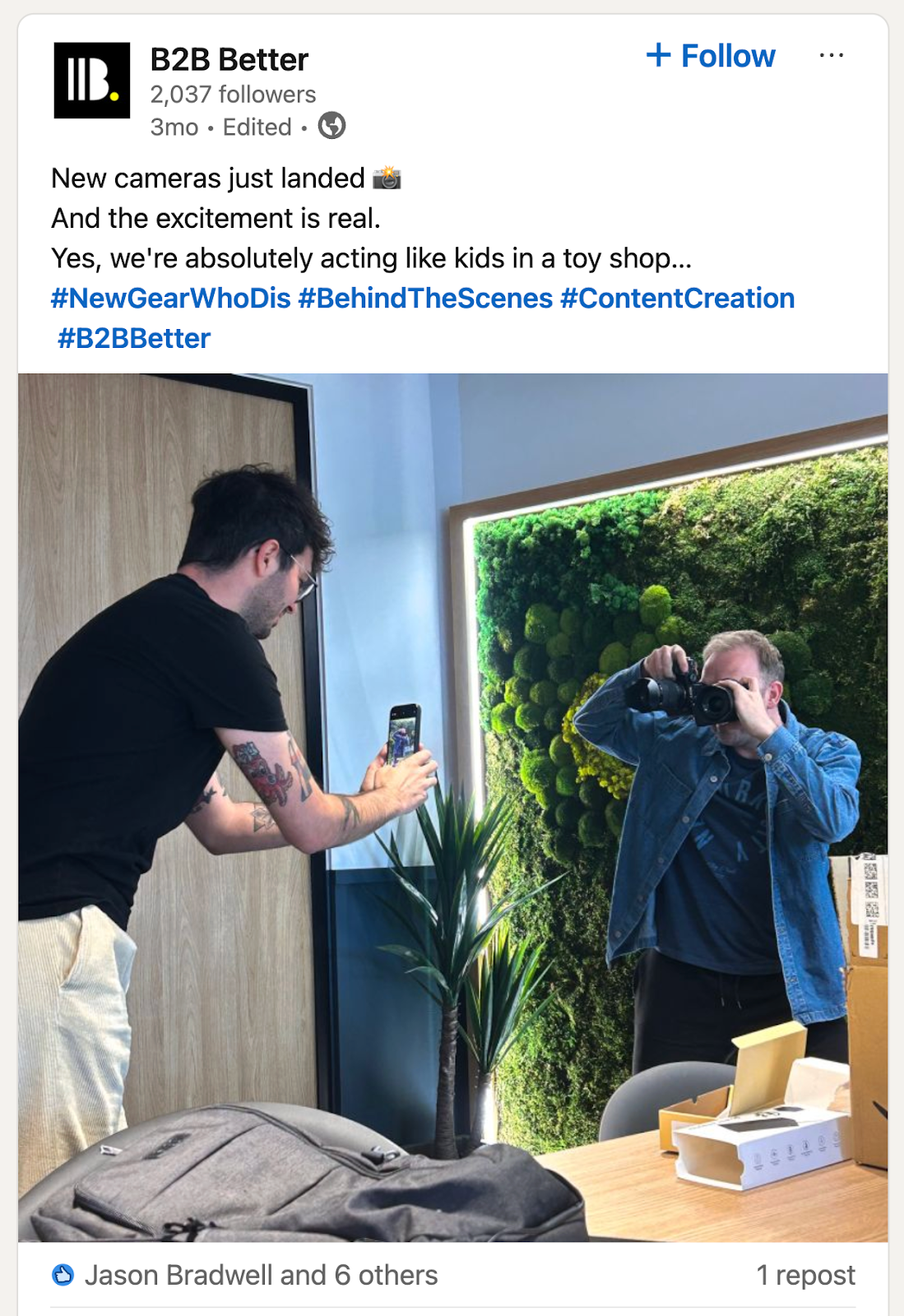
For creators, it’s an opportunity to show what goes into your work, or the messy middle before something comes together. You could share how you landed a client, what your creative setup looks like, or what a typical day looks like.
These moments help people see the real person behind your brand and your content, and that’s what makes them stick around.
User-generated content, memes, and trends
LinkedIn isn’t all serious business talk. You can post user-generated content (UGC), memes, GIFs, and ride pop culture trends doing the rounds across different social media platforms — if you’re selective about when and how you do it.
Not every meme or viral moment will align with your target audience or message, and forcing it can make your content feel out of touch instead of relevant. If you’re unsure of whether it may work for your audience or not, let your brand tone and style guide you.
“Understand who you are to your audience first, then decide if the trend fits that role,” says Sophie Miller. “Are you the trusted adviser? The industry disruptor? The relatable expert? Your content needs to match those expectations, even when you’re jumping on trends.”
If a meme or trend aligns with how your audience sees you, go for it. If it doesn’t, it’s better to skip it and wait for something that does. When used thoughtfully — like Gong did with the Destiny’s Child reunion — memes and trends can make your content relatable.
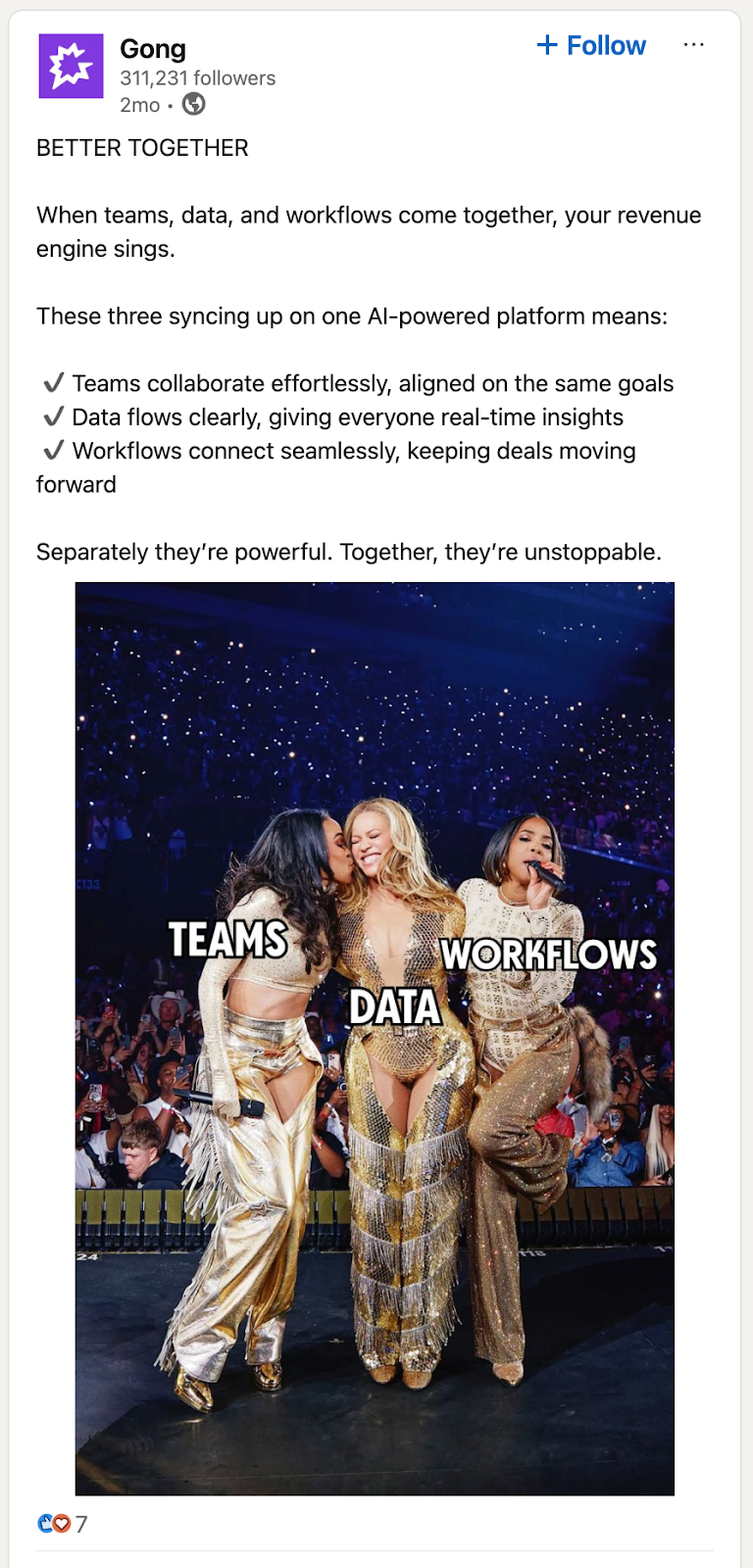
There’s also user-generated content as a way to bring your customers into the conversation. You can share posts or videos they’ve made on their own, or team up to create something together. It makes your audience part of what you’re building instead of people watching from the sidelines.
Buffer often teams up with community members to create content for LinkedIn and other platforms. It gives us an opportunity to share content that speaks to and sounds like our audience — because it comes from them.
Testimonials and case studies
You know how people connect with people, not logos? People also trust people — and social proof works just as well on LinkedIn as it does anywhere else.
Sharing a graphic with a quote from a happy customer, or a video testimonial like Todoist did, gives people a reason to trust what you’re offering. It shows your impact through someone else’s words, not your own.
The same idea applies for creators. You can highlight a client win, a collaboration that turned out great, or feedback from someone who’s used your work. You don’t need a full-fledged video case study. Even a screenshot of a Slack message shows the impact of your work in a way that’s more convincing than you listing your accomplishments.

Roundups
Roundups work well on LinkedIn when you want to keep people in the loop without them having to hunt for information. You can pull together industry news, interesting reads, tool updates, or job openings that your community would want to know about. They show that you’re paying attention, not just to your own work, but to what’s useful for your audience.
Two Buffer teammates post weekly job roundups every week. Brandon Lucas Greene, Staff Product Manager, shares remote product jobs. Simon Heaton, Director of Growth Marketing, shares remote marketing jobs.
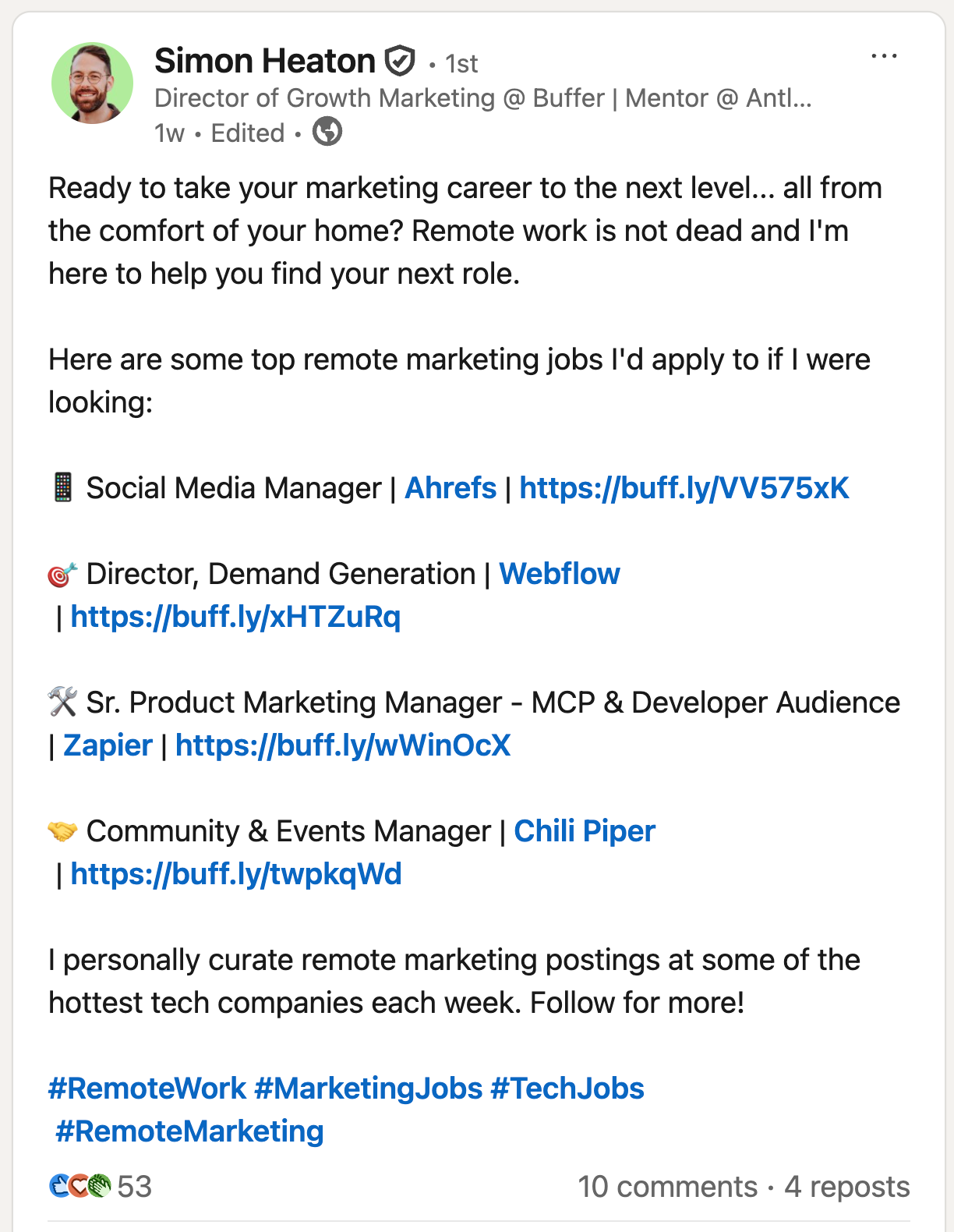
Simon shares these roles every week because he wants his posts to be helpful to his audience, not just visible. “I believe deeply that remote work works, and I want to help people access great roles at forward-thinking companies,” he says. “LinkedIn is still, in many ways, a job marketplace layered with a social network. Sharing roles where people already look for opportunities just makes sense.
“This also gives me a recurring series that helps me grow reach, build relationships, and deliver consistent value without turning content into noise.”
If you post your roundups on the same day each week, people will come to know when to expect them. That regular cadence means they don’t have to scroll through multiple feeds or newsletters to find what they need. And when people know they can count on you to deliver valuable content, they’ll keep coming back for it.
How to create your LinkedIn marketing strategy
Now that you know the types of content you can post — and how each one performs — the next step is to turn that knowledge into a plan.
A LinkedIn marketing strategy brings together three things:
- your goals
- your audience
- your content
When those pieces line up, you can build a repeatable process that helps you stay consistent, use your time well, and actually see what’s working.
Think of your LinkedIn strategy as a roadmap for showing up with purpose. It’s how you decide what to post, who it’s for, and how you’ll measure success so that your content moves you closer to your goals.
1. Define your goals
Every successful LinkedIn marketing strategy starts with clear goals: What do you actually want to achieve on the platform? Your answer will shape everything that follows, from the topics you post about to the kind of conversations you join.
Companies may want to use LinkedIn marketing to recruit new talent, generate leads, build brand awareness, or increase brand visibility. Your LinkedIn marketing goals should align with your business objectives.
For creators, the goals look a little different — they often center on visibility and opportunities like landing clients, growing a personal brand, or getting a new job.
Once your goals are clear, every post has direction and it becomes much easier to see what’s moving you forward.
2. Identify your target audience and content pillars
If you’re a business owner or social media marketer, you probably already have a clear picture of your target audience from your ideal customer profile (ICP). If that’s not locked in yet, our guide to marketing personas can help you get there. For creators building a personal brand on LinkedIn, our personal brand framework walks through the same process from a different angle.
Once you know who you’re talking to, your LinkedIn content should focus on creating value for them. In my experience, this starts with understanding their pain points and tapping into your expertise to help solve them.
This applies whether you’re a business with a team of specialists or a creator working on your own. And you don't need a corporate job or a fancy title to have expertise worth sharing.
“A lot of people would often ask me, ‘I’ve never had a corporate job, what should I be posting?’” says Callie Schweitzer. “You are an expert in your life experience. We’ve seen so many creators on the platform embrace that and recognize that the word ‘professional’ means so many different things right now.”
Laura Lorenzetti also recommends looking at what other people in your industry or niche are talking about and building on ideas.
“Everyone’s starting a conversation, and it’s great when communities come and continue to build on that conversation,” she says. “We shouldn’t be afraid of [doing] that. Reference it, give that person credit, build on that idea, and add your examples.
3. Create a content calendar
A social media content calendar is what keeps your LinkedIn marketing strategy organized. It gives you a clear view of your week (or month) so you can see how your posts connect and keep everyone on the same page.
Here’s why you need one:
- It keeps your content organized: You’ll always know what’s coming up and what still needs to be created.
- It makes it easier to plan campaigns: Campaigns make more sense when you can see how posts connect over time. You'll spot where something doesn’t line up, when a post needs to move, and how the whole thing flows before it goes live.
- It helps you plan ahead: With a view of what’s coming over the next few weeks, you can create posts in advance and save time.
- It keeps your posting consistent: A calendar helps you stick to a regular rhythm on LinkedIn. That consistency builds momentum and keeps you visible to your target audience.
How often should you post on LinkedIn?
A calendar packed with posts might feel like progress, but remember to be realistic with what you can actually keep up with.
“If you’ve never posted or have posted zero times in the last month, don’t set a New Year's resolution that you're going to post every day,” says Callie. “That’s unrealistic, and it’s going to feel forced. Think about what’s reasonable for you and take it from there.”
If once a week is all you can manage, that’s better than not posting at all. But if you can post more, LinkedIn rewards it. More posts mean more chances for your content to surface, and the effect compounds over time.
Here’s what Buffer’s data shows from an analysis of more than 2 million posts.
- Posting 2 to 5 times per week gives you an extra 1,182 impressions per post on average, with engagement rates climbing 0.23 percentage points.
- Posting 6 to 10 times per week brings 5,001 additional impressions per post and a 0.76 percentage point lift in engagement.
- Posting 11 or more times per week delivers massive gains: 16,946 extra impressions per post, engagement up 1.40 percentage points, and 3x more engagements overall.
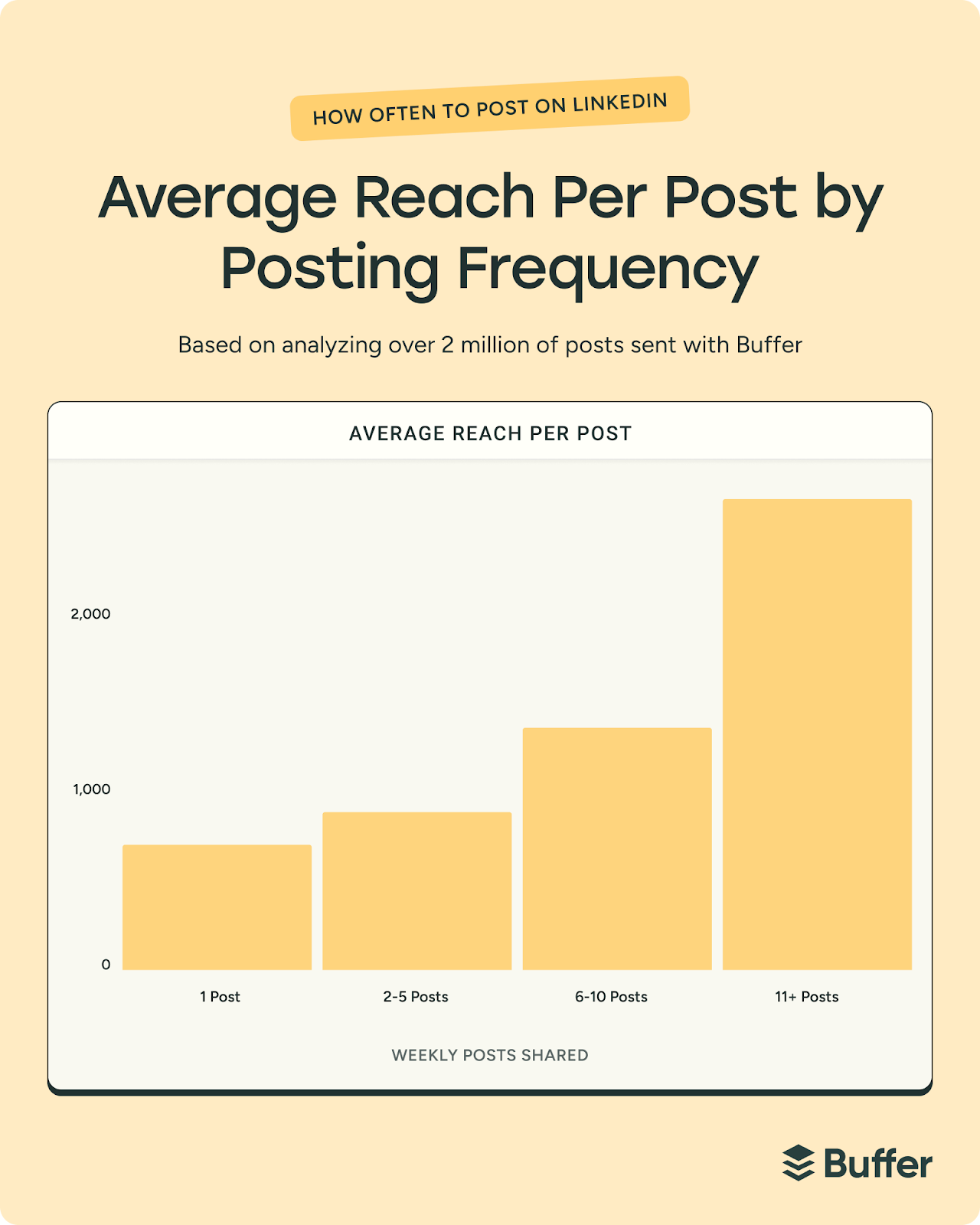
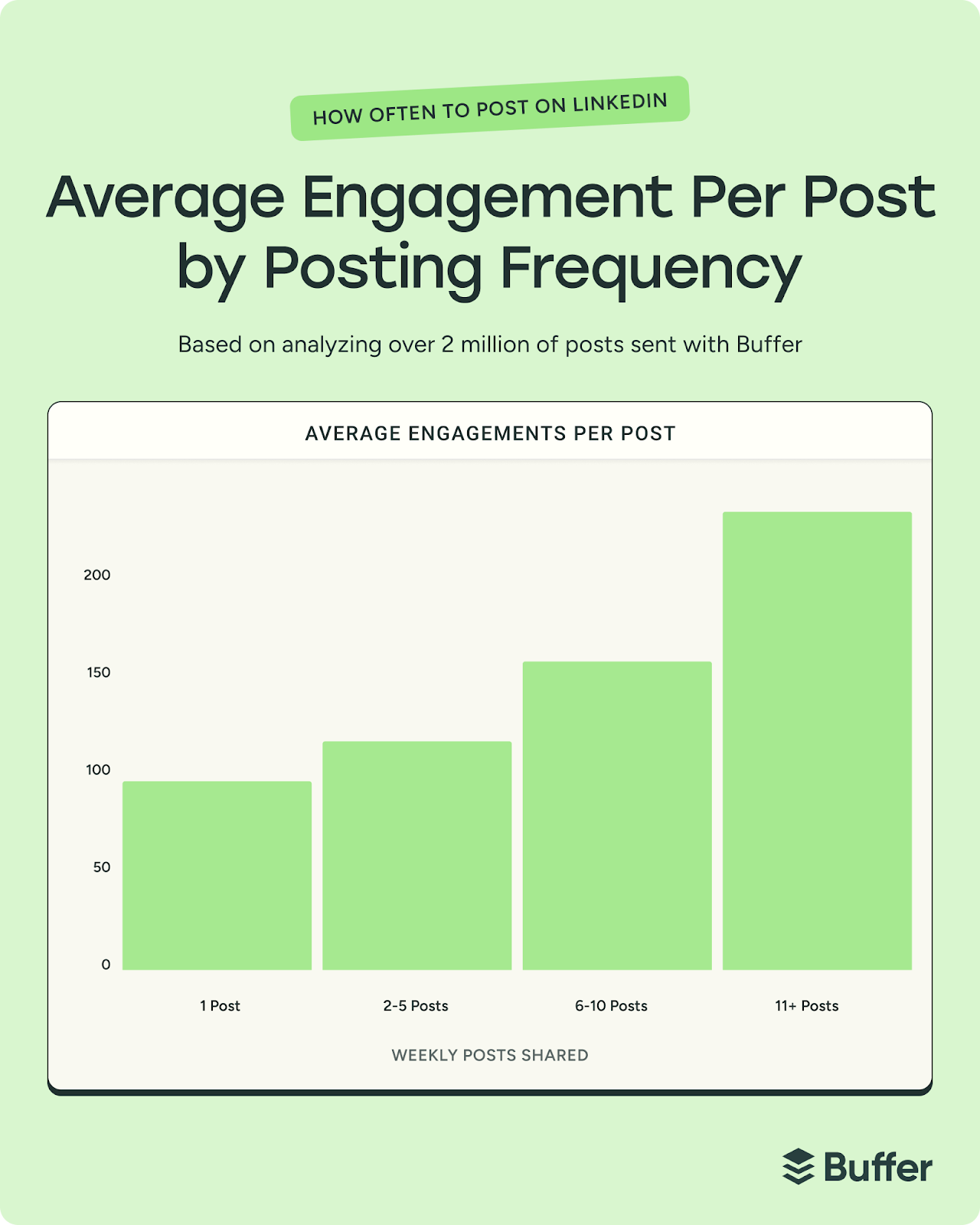
Your follower count doesn’t change how this works. Whether you have 500 people following you or 50,000, posting more often makes each individual post perform better.
How often you post from your LinkedIn Page also impacts follower growth. Companies that post weekly grow followers 7x faster than those that post monthly. Post daily, and you can grow followers 8x faster than posting weekly.
That said, frequency alone won’t carry you. Watch how people engage with your posts and let that guide how often you show up.
“Daily posting is optimal to maintain consistent engagement with your audience, but be sure not to overdo it and avoid overwhelming your audience,” Hien Mai, Product Marketing Manager, Creator Growth at LinkedIn, told Buffer.
“If your comments and engagement on a post remains consistent, that’s a good sign that your content is engaging.”
What you need to set up your content calendar
Once you know how often you’ll post, the next step is setting up a system to plan and organize it all.
- Topics or types of content: Map out what you’ll post: industry or company news, educational posts, behind-the-scenes stories, evergreen tips, Q&As — whatever fits your LinkedIn strategy. Add placeholders for upcoming campaigns, launches, or events so nothing gets missed.
- Posting frequency and schedule: Plan when you’ll post — the specific days or times of the week. We’ll cover how to find the best posting times a little later.
- Social media platforms you’ll post on: Even though this guide focuses on LinkedIn, your calendar should ideally show the full picture across all the social platforms you use. This allows you to easily see your entire social media marketing strategy in play, not just your LinkedIn marketing efforts. You can do that using a social media management tool like Buffer.
- Content calendar tool: You can build your calendar in a spreadsheet, a diary or planner, a project management tool, or a social media management tool.
You can set up your content calendar directly in Buffer. Connect your channels, invite your team, and you’re already on the way. You can capture ideas, draft posts, add media, get approvals, and publish to multiple channels without switching tools, all from within Buffer.
4. Schedule your LinkedIn posts
Scheduling your content is one of the easiest ways to stay consistent without needing to stop what you’re doing every time a post needs to go live. With a social media management tool like Buffer, you can plan and queue content ahead of time so it goes live exactly when you want, whether you’re in a meeting, on vacation, or just offline for the day.
It’s worth noting that scheduling doesn’t hurt your reach. You may have seen claims that using third-party tools limits visibility, but let’s clear that up: it’s a myth. LinkedIn itself recommends scheduling posts with tools like Buffer as a best practice for sharing content.
If you’re wondering when to post for the best results, there’s data to guide you. Buffer analyzed more than a million LinkedIn posts and found weekdays generally perform best, with Thursday taking the top spot, followed closely by Wednesday and Tuesday. On those days, engagement tends to peak at 10 a.m. on Tuesday and Thursday, and 3 p.m. on Wednesday.
These times make a great starting point if you’re still testing your LinkedIn strategy. Once you’ve been posting for a while, you’ll want to refine your timing based on what works for your specific audience.
LinkedIn’s native analytics don’t show you exactly when you posted something — neither the date nor the time — and a tool like Buffer can help fill that gap. Here’s what you can learn from Buffer analytics:
- LinkedIn Pages: Buffer shows you which day of the week your posts get the most engagement. This data comes directly from how your audience interacts with your content, so it’s specific to you.
- LinkedIn profiles: You can see metrics for each individual post from the scheduler — data like impressions, reach, and engagement, plus both the date and time the post went live. Look for patterns in this data to figure out when your audience is most likely to engage.
5. Track your content’s performance
Setting up a social media content calendar for LinkedIn isn’t a one-and-done job. It’s an ongoing process where you’ll check in on your LinkedIn analytics regularly to double down on what’s working and tweak what’s not.
LinkedIn profile analytics
Creators have access to a detailed set of LinkedIn analytics that can help guide what to post next. To find them, click on Me in the top menu, go to View profile, and scroll to Analytics. Then select Show all analytics.
You’ll find data on four main social media metrics:
- Post impressions: How many times your posts showed up on someone’s screen.
- Followers: How many people currently follow you, whether they’re connections or not.
- Profile viewers: How many people stopped by your profile.
- Search appearances: How often your profile appeared in LinkedIn search results.
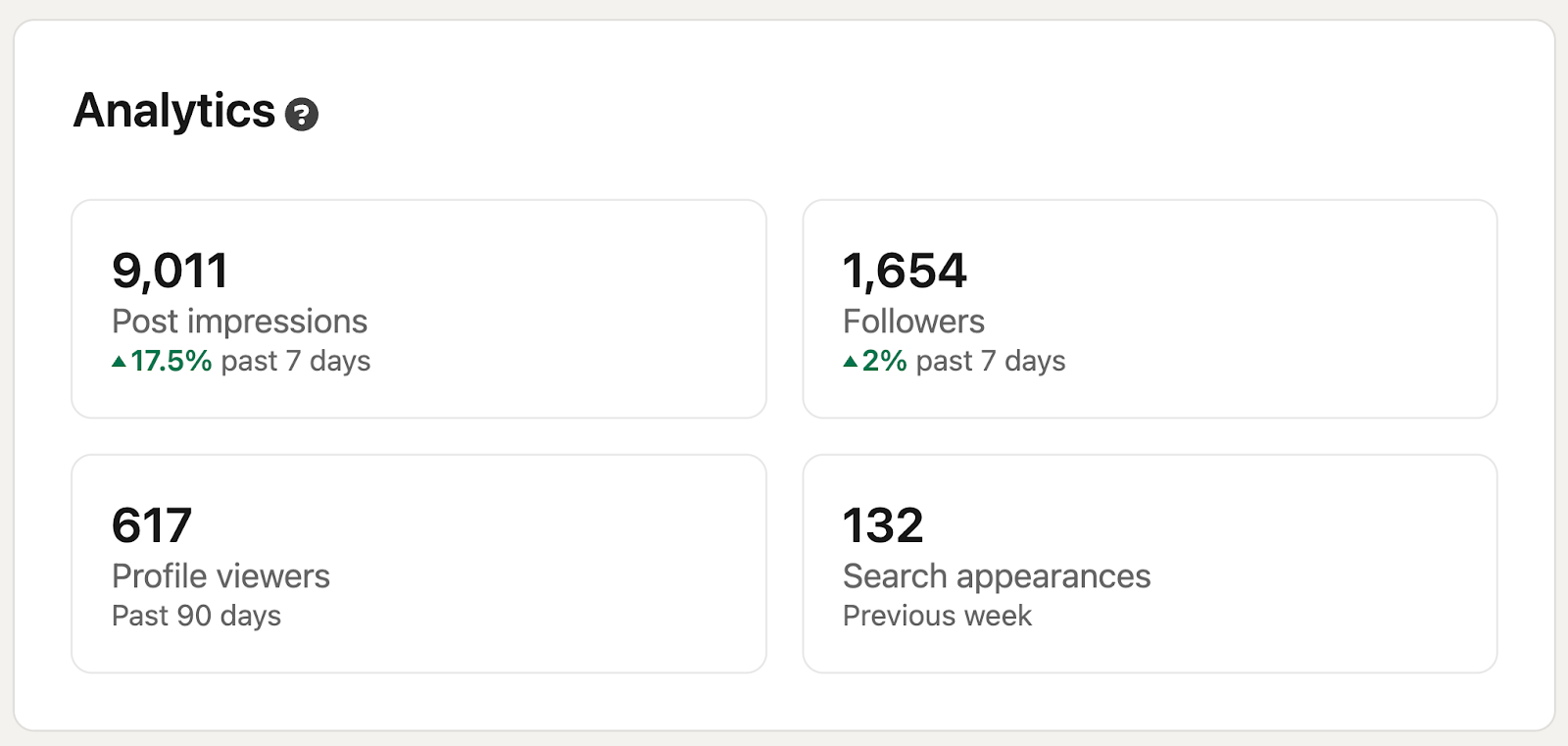
Each metric offers a deeper view if you click through. Rishi Jobanputra shared a few ways to use these insights:
- Comments: The best way to tell if your content is connecting is to look at the conversations it starts. “Conversations are a great way to understand if your content is working and if our members are finding it helpful,” he says. “Are people adding their own insights or asking questions in the comments? Are people messaging you directly to learn more?”
- Who's viewing your profile: Look at what industries your viewers are in and the seniority levels they hold. “Knowing who is seeing your content can help you better tailor future posts to your audience's interests,” he says.
- Profile viewers and new followers from a post: Rishi adds that steady growth here is a good signal. “If the number of people viewing your profile and following you is increasing each time you post, that signals that your content is heading in the right direction,” he says.
The specific metrics you focus on will depend on your goals. “Engagement is a huge success metric for me,” says Tami Oladipo. “Do people like the content? Going a step further, do they say things about it?
“I have a pretty clear idea of who my audience is, so I try to get in their shoes and mindset with each piece of content I make. So if they like and respond to it, that means I've done my job.”
LinkedIn profile analytics with Buffer
While LinkedIn’s profile analytics show your core metrics, Buffer adds post-level details like the exact date and time alongside impressions, reach, and engagement, so it’s easier to spot timing patterns and compare performance over any window.
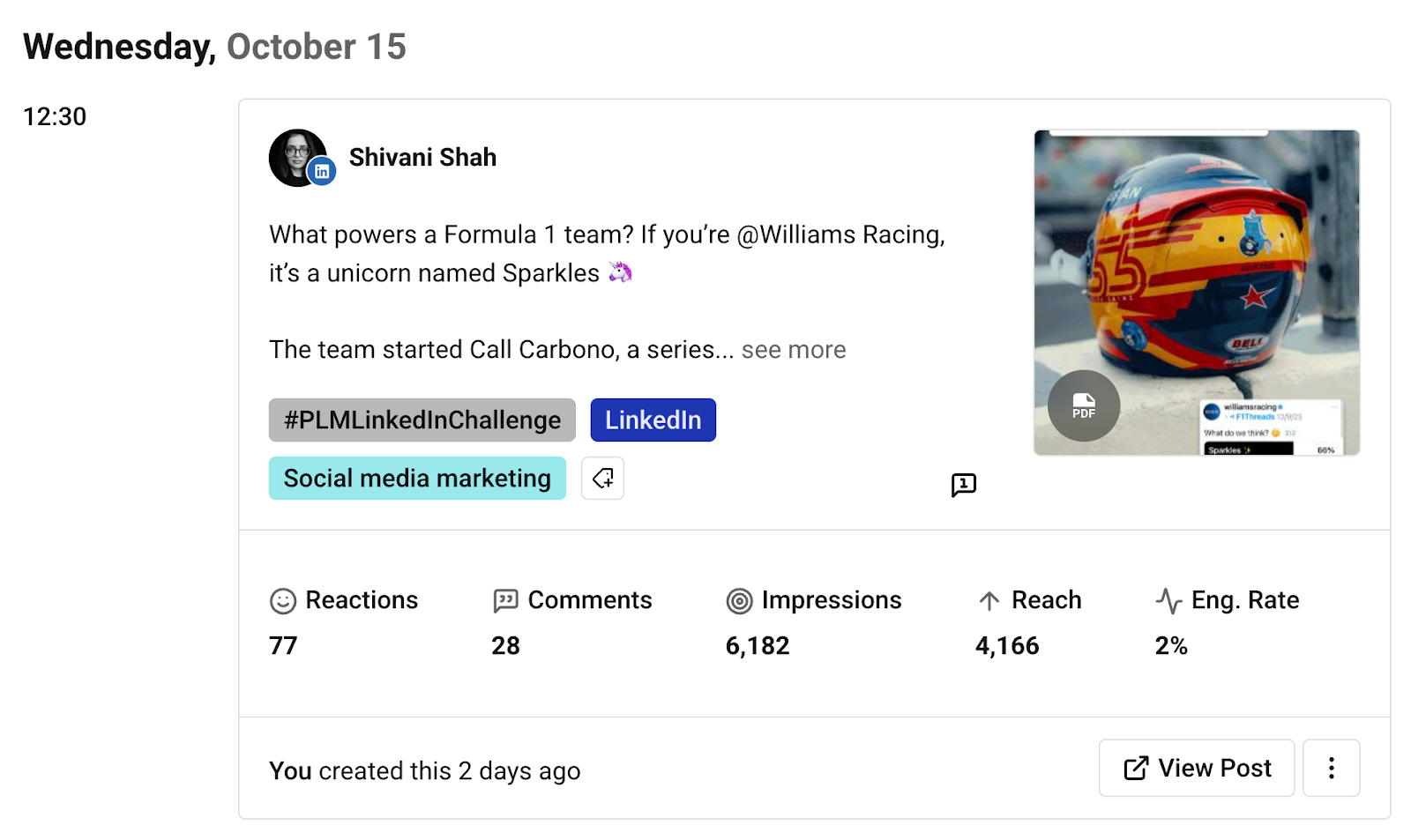
Sabreen Haziq, Senior Brand and Community Manager at Buffer, uses analytics to spot patterns in what performs best.
“Some of the posts that travel the farthest for me are the simplest, quick thoughts that start real conversation — not the polished pieces I expect to shine,” says Sabreen. “The data helps cut through assumptions and gives me the confidence to keep showing up.”
LinkedIn Page analytics
Besides measuring your LinkedIn marketing performance, your LinkedIn analytics works as feedback from your audience: what’s working, what people are responding to, and where to tweak. You’ll find them by heading to your Page and selecting Analytics from the left-hand menu.
Here’s what you’ll see:
- Content: How all your posts perform, which you can filter by impressions, unique impressions, clicks, reactions, comments, reposts, and engagement rate.
- Visitors: How many people are viewing your page, which can be filtered by both page views and unique visitors.
- Followers: An overview of your total and new followers in the past 30 days, plus insights into follower demographics.
- Leads: Details on potential customers gathered through LinkedIn Lead Gen Forms.
- Competitors: Track and benchmark competitor performance on LinkedIn. You’ll see an overview of their follower metrics, organic content performance, and trending posts. You can add one competitor if you have a free Company Page, and up to nine if you have Premium.
- Employee advocacy: Gauge trends in employee and member engagement with content recommended to employees on the My Company tab.
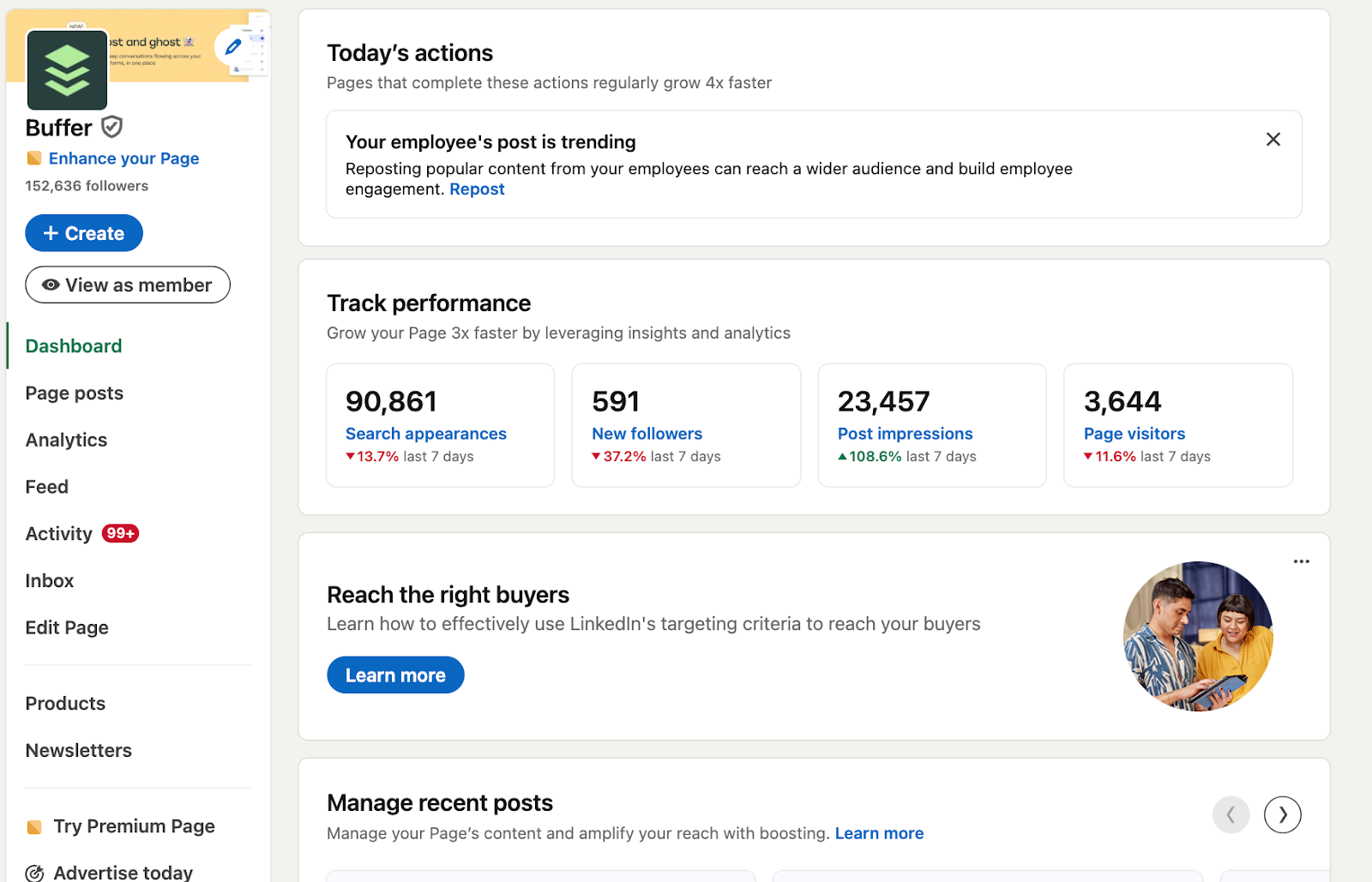
I get it: this is a lot of data, and it may be overwhelming if you’re new to LinkedIn marketing. Start by focusing on two areas:
Understand what content performs best
To find out what LinkedIn content your followers like, go to Analytics > Content and scroll to the engagement table. Look for posts with much higher (or lower) impressions and clicks than the rest.
Use those insights to experiment. If the post fell flat, try to pinpoint why. Was it a bad time to post, or was the format something that didn’t resonate with your audience? Do the same for your top performers and experiment with replicating different elements in new posts to see if you can nail down why the post was such a success.
Learn about your followers and visitors
Under Analytics > Followers, explore demographics like location, job function, company size, industry, and seniority. You can also see similar data for people visiting your Page but not following yet under the Visitors section.
This data can be immensely helpful in creating new content that speaks to a large chunk of your audience.
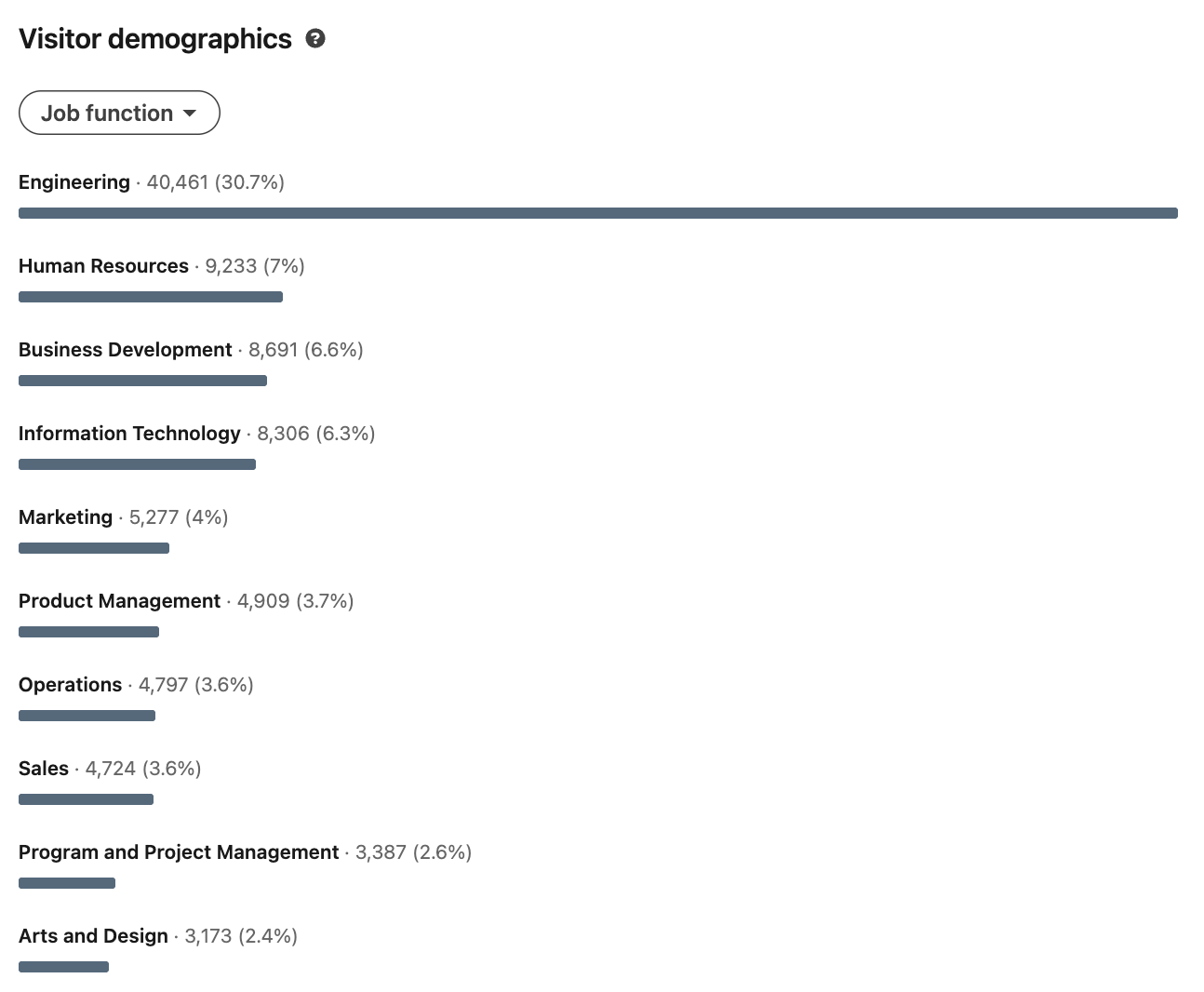
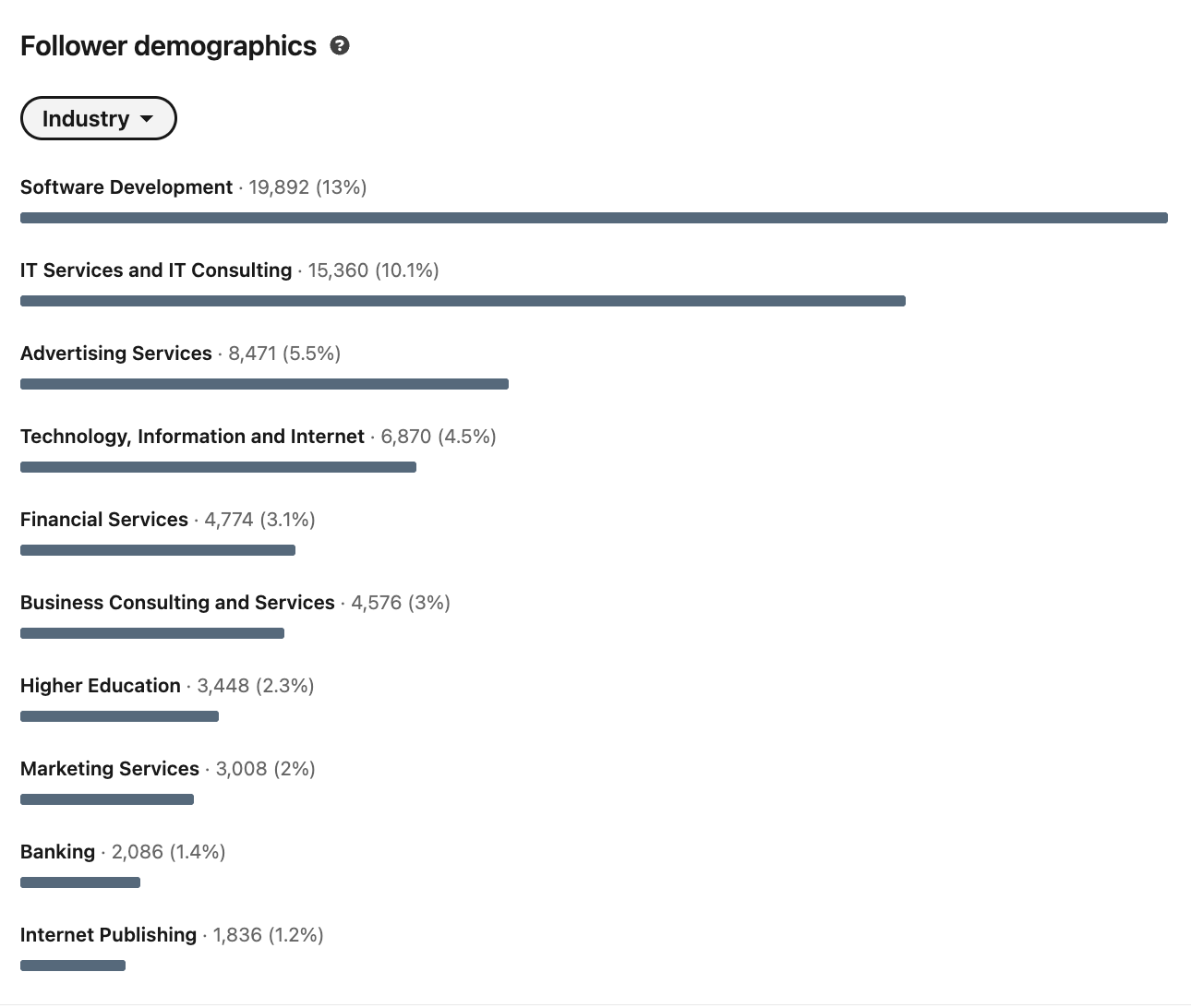
At Buffer, we use this information to shape what we share. We tailor our posts for the right audience by sharing content relevant to their job functions. This could include content on marketing (which we write a lot about), startups, and technology.
LinkedIn Page analytics with Buffer
When you manage your LinkedIn Page through Buffer, you get detailed analytics on how your content is performing and how your audience is growing.
To access it, log into your Buffer account and click on the Analyze tab at the top. From there, choose LinkedIn from the channels list on the left.
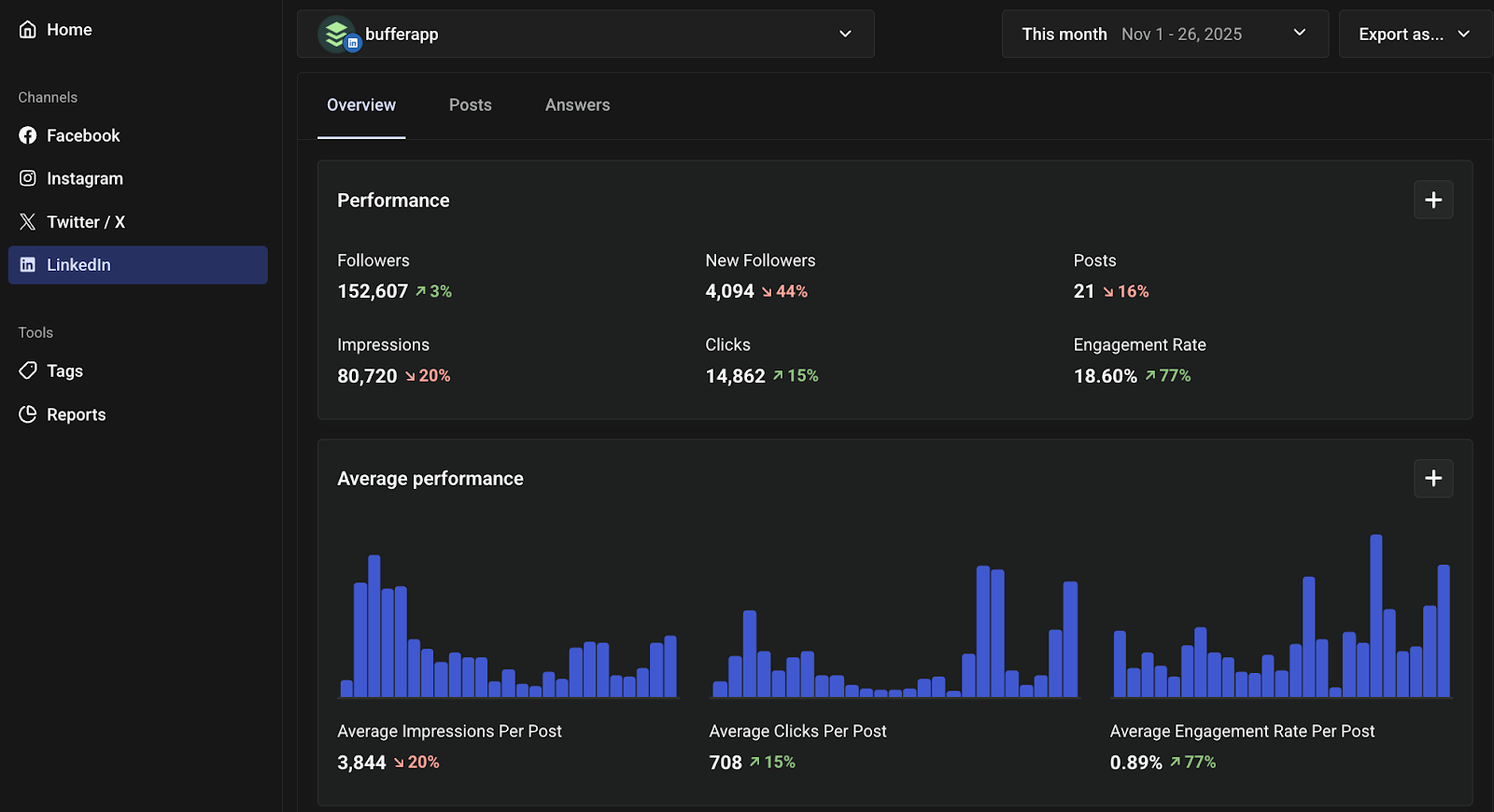
Buffer tracks data on number of posts, impressions, clicks, likes, comments, shares, total followers, and new followers. Beyond the raw numbers, you get personalized recommendations based on your own data, including:
- Which types of posts — like carousels, images, or videos — perform best for your Page.
- The best day of the week to post on LinkedIn based on your audience’s engagement patterns.
You can turn these insights into custom analytics reports, making it easy to show what’s working and demonstrate the impact of your LinkedIn marketing efforts.
5. Engage with your audience
Whether you manage a LinkedIn Company Page or a personal profile, this advice applies. The LinkedIn algorithm prioritizes engagement — likes, comments, and reposts — so the more interaction your posts get, the more the algorithm learns who else might find them valuable.
And if you need another reason to engage, LinkedIn has given us a clear signal that it values conversations by displaying comment impressions.
Here’s how to thoughtfully engage with your audience on LinkedIn.
Create compelling content that invites engagement
Sophie Miller says the biggest shift she’s seen on LinkedIn is that audiences don’t just want to consume content anymore — they want to participate in it.
“So instead of asking ‘What should I say?’ start asking ‘What conversation am I trying to start?’ and most importantly ‘How do I make it easy for people to join in?’” she says. “Create content that invites real responses rather than just collecting likes.”
This doesn't mean every post needs to be a deep thought leadership piece. Sophie also loves creating what she calls ‘thin content’ — posts that don’t sell or educate heavily, but give people something easy to engage with first, she says.
“Simple calls to action like ‘drop a 👋 if you’ve been there’ or sharing a relatable struggle that makes people think ‘can she see inside my brain?’,” says Sophie.
“The goal isn’t deep engagement immediately. It’s building the habit of interaction. Once people get comfortable engaging with your content in small ways, they’ll start trusting you with bigger conversations.”
Keep the momentum going by responding to comments
Make some time to respond to comments on your posts. It pays off. In Buffer’s analysis, posts where creators replied to comments outperformed their usual engagement, with roughly 83% of profiles seeing higher engagement when they turned comments into conversations.
Brands that treat LinkedIn marketing like a one-way street often struggle to see results. The fix is simple, says Sophie: start talking back. “Get involved in comment sections, reply to people, start conversations,” she says. “Spend as much time engaging with other people’s content as you do creating your own.”
Take it further by commenting on other people’s posts
It helps to look beyond your own content and get involved in conversations happening across your network. Many creators find their follower count grows faster when they actively comment on other people’s posts and take part in meaningful discussions.
“Focus on the compounding actions that make your content stronger over time,” says Sabreen. “That means engaging with other creators in your niche, taking the time to respond thoughtfully to people who follow you, giving shoutouts, and making it a habit to connect with more folks in your industry each week.
“It’s those small, interlocking actions that widen your network, build community, and ultimately lift your content performance.”
A quick note for businesses: While this makes sense for creators building their personal brands on LinkedIn, it might be a little tricky with LinkedIn Company Pages. Jumping into the thread as a brand might come across as pushy or sales-y.
On the other hand, if someone has mentioned your brand in their post, don’t leave them hanging! LinkedIn offers you an easy way to keep up with mentions, too. Just head over to your page, click Activity on the left-hand side, then choose Mentions.
6. Support employee advocacy
If you run a LinkedIn Page, one of the best groups of people who can help with your LinkedIn marketing is your colleagues or employees. When they engage with your company’s content and build their own presence on LinkedIn, they amplify your reach in ways that ads never could.
“We’re in a new era where people want to hear from people,” says Laura Lorenzetti. “The faces behind a business are the business. And that’s what people care about and [who] they want to hear from.”
The numbers back this up. Dave Yang, Head of APAC – SMB and Mid Market at LinkedIn, shared data that shows the impact of employee voices:
- 87% of buyers trust content from real buyers over ads
- Employee posts get 12x more reach than brand pages
- Execs get 7x more engagement than brand pages
- Three out of four decision makers say thought leadership is more valuable than traditional marketing
Here at Buffer, we’re putting programs in place to empower the whole team to become creators (on any platform/s), and many of the team are regular LinkedIn creators.
“The point of building creators is to build people up and help them grow their own voice and perspective,” says Sabreen. “When that happens, any time they do talk about the company organically, the impact stretches much farther than scripted marketing ever could.”
How to help your team help you:
- Encourage them to engage with your posts: Make it easy for your colleagues to engage with the content. Send them links every time you post or when important updates go live. Sometimes, a quick message asking for engagement is all it takes.
- Encourage them to fill out their LinkedIn profiles: LinkedIn explains how your team’s individual LinkedIn profiles influence your brand: “Keeping your profile up to date is one of the most impactful ways to improve your contact rate. People do business with other people, so profiles matter.” Besides that, it’s just a wonderfully simple way to spread brand awareness. If you have a company of 50 people, that’s 50 profiles with your company’s name and a quick link to your Page. According to LinkedIn, this makes your company more visible in search results both on and off the platform.
- Help them build their personal brand on LinkedIn: This one takes a bit more effort, but you’ll see the return on investment in spades. Plus, creating company thought leaders is a win for both the business and the employee: LinkedIn says that content posted by employees has a click-through rate twice as high as brand accounts.
There's another benefit worth mentioning: employee advocacy builds internal team engagement, not just external reach. When your team is active on LinkedIn, they become more invested in the company's direction. According to LinkedIn, these employees are 27% more likely to feel optimistic about where the company is headed and 15% more likely to feel connected to colleagues outside their immediate team.
Empower employees to build their personal brands
Employee advocacy works best when it starts from the top, and getting clear leadership buy-in is the first step. “Personal brand building has to be a core company initiative, not just a bonus project,” says Sabreen.
“It won't take off if it’s treated as reactive or ‘just another idea’ — it has to be reinforced by the CEO, founders, and managers, with a clear connection to long-term growth and company-wide impact.”
So, where should you start? We’ve got a thorough guide to empowering your employees to build their personal brands on LinkedIn, but here’s a quick summary:
- Help them find their niche: Help your team find topics they’re passionate about and know well. Our guide on how to find your niche can help.
- Provide guidelines: Share best practices for LinkedIn posts, focusing on content that fits your brand without putting their voice in a box.
- Support them where possible: Whether that’s an in-depth personal branding course or occasional guidance, both go a long way!
- Celebrate their wins: Give a shoutout to your team for their achievements, whether that’s sharing valuable insights, reaching follower milestones, or just consistently showing up on LinkedIn.
- Lead by example: If company leadership also creates and shares content, it might feel more accessible to them.
- Give them the time and tools they need: Building a presence on LinkedIn takes time and effort. Encourage your team to engage during their working hours. Tools like Buffer make it easier to plan, post, and stay consistent.
Tips and tools for staying consistent on LinkedIn
If there’s one thing our data makes clear, it’s this: consistency wins.
Whether you post once a week or several times, staying consistent week after week can help grow your LinkedIn profile or page.
We’ve run the numbers on consistency, and the results show exactly how much it matters.
Buffer users who showed up highly consistently saw around five times more engagement per post than those who posted inconsistently. Meanwhile, consistent users still saw more than triple the engagement of the inconsistent group.

And behind every data point, there’s a real story.
Sabreen posted every day for a year and grew her audience by 684%. Buffer teammates Tami and Hailley Griffis, and creators Aarushi Singh and Sweta Sharma have all seen consistency turn into growth — not because they followed the same formula, but because they found a cadence they could stick with.
According to Tami, the real barrier is the unrealistic expectations creators often set around consistency.
“Consistency is one of those unglamorous truths that growth is built on, but people often overcomplicate it,” she says. “They imagine it means posting daily at the same time with a content calendar planned six months out.
“What I’ve learned, and what Buffer’s data confirms, is that consistency just means setting a cadence you can sustain and sticking with it.”
Let’s look at a few systems and tools that can help you stay consistent — and keep ideas flowing without burning out.
1. Capture content ideas
Ideas don’t stick to a content creation schedule. They often show up at the most inconvenient times, like when you’re in line for coffee or halfway through another task. The easiest way to hold on to them is to capture them right when they happen.
I use Buffer’s Create space to do this. I’ll record a quick voice note to jot down the idea instead of typing, and Superwhisper pastes the transcript directly into Buffer. There are many AI dictation tools that can get the job done, or you can use your phone’s built-in transcription tool if you’re using the mobile app. And if speaking (or thinking) aloud isn’t for you, you can also type them into the Create space or your notes app.
Once the idea is saved, it sits in a bank of content ready to add to my calendar whenever I need it. If you’re strapped for ideas, you can tap into your community and add those insights to your Create Space.
Sabreen uses AI to build on posts that have already performed well. “One of my favorite uses of AI is idea extension,” she says.
“If a post performs well, I ask what else I can write to build on the theme, or what natural sequel might deepen the conversation. That curiosity loop helps me create momentum at scale without reinventing the wheel.”
2. Set aside time to batch create your content
It’s no secret that creating content takes time and focus. And when you’re juggling everything else that comes with managing social media, it’s easy to get sidetracked and lose momentum.
There’s a solution: create content in batches. Put it on your calendar — no plans or meetings to derail you! — and you have focused blocks of time to work without distractions.
Every social media manager and content creator works differently, and your content calendar will probably look different from week to week too. This means there’s no single formula for how to do it.
Shooting and editing a single video might take as long as drafting a few text posts. You might want to knock out several carousels in one go or spread them across a few sessions.
The goal is to block time that feels realistic — a focused afternoon, a few hours each week, or short sessions spread across your calendar — and helps you stay consistent without burning out.
This is where the work you did earlier pays off. “Having a bank of ideas makes batching so much easier, because there's already good material to work with,” says Sabreen. “When I've built up a pool of ideas in my Buffer Create space, I’ll set aside time to polish them, add depth, and bulk create.”
You can bring AI tools into that process, too. Sabreen uses ChatGPT for brainstorming, while I use Descript to edit video and Gamma to design carousels. They help speed up production once your ideas are ready to go.
And like everything else in social media, it’s fine to stay flexible. “When time is tight, I’ll post on the fly,” she says. “I just make sure to flesh out the narrative before hitting publish.”
3. Repurpose content
You don't have to start from scratch every time you’re posting content on LinkedIn. Many of your followers haven’t seen your older posts — and new connections definitely haven’t — so repurposing content gives your best work a second life without requiring you to create something entirely new.
An even bigger bonus: it’s a good idea because it brings consistency in what you talk about, says Laura.
“The more you’re associated with an idea and expertise the better,” says Laura. “You can go deeper into that. I wouldn’t be afraid of repeating [myself], because people don’t see every single post. But they still get value out of another way of phrasing it or a new context or example that adds on to that expertise.”
Pull your best performing posts and share them again in new ways. You can:
- Try a new format: Turn a thread into a carousel, or a text post into a video.
- Shift the focus: Approach the same idea from a different angle or expand on a point you only mentioned before. The way Sabreen uses AI for idea extension can work well here too.
- Experiment with timing: Posting at a different day or time can help you reach new segments of your target audience. If it’s been a while since you last shared this post, check your Page data in Buffer analytics to see what’s working best for your audience right now.
Repurposing content means you don't have to constantly chase new ideas, because you’re building on what’s already performed well.
“There’s knowledge, examples, and learning that are evergreen, but when they’re rephrased, refreshed, or new in your feed, people can engage with that again,” says Laura.
“They can have a new conversation, make new connections, and bring that to the forefront of the ‘now,’ because there are learnings that become more resonant over time.”
It’s also great for visibility. You give your evergreen content an extra SEO boost and another shot at ranking on Google to send people to your profile.
Pro tip: You’re not limited to repurposing from older LinkedIn posts. Pull highlights from your blog, newsletter, podcast, past interviews, or even a research paper, and turn them into LinkedIn content. That way, each piece of content keeps working harder for you across multiple platforms.
I’ve done this myself, taking one of my best-performing X/Twitter posts and re-sharing it on LinkedIn (twice, two years apart). The post reached a completely different audience on LinkedIn than it did on Twitter. And the second time, it saw a higher engagement rate than the original repurposing.
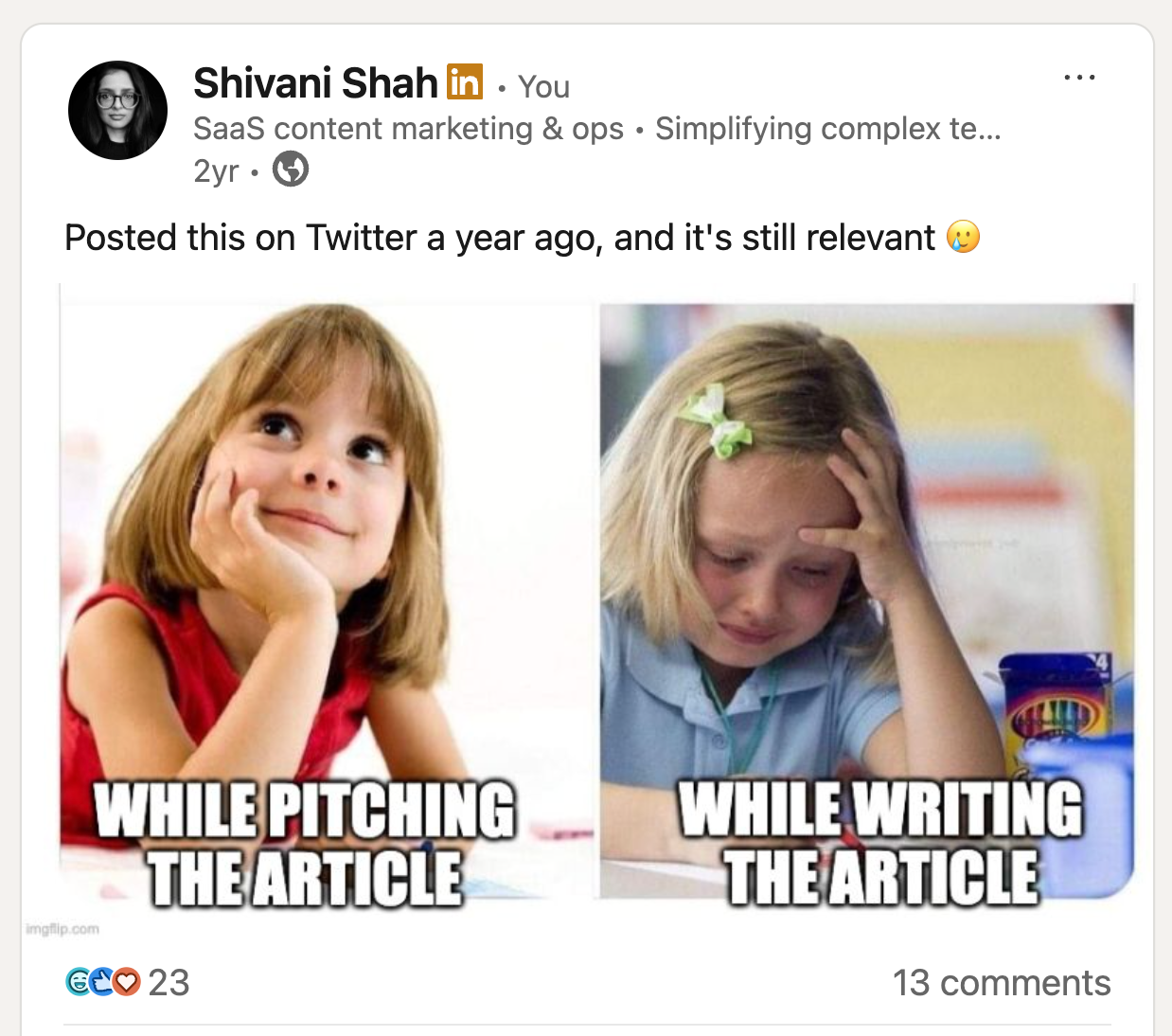

You can also set up automations to make repurposing easier. When you publish something new — like a blog post or podcast — create an automation that reminds you to turn it into a LinkedIn post a few weeks later. It keeps your content loop running smoothly without adding too much work to your plate.
Monetizing your LinkedIn presence
If you’re a creator, partnering with brands can turn your LinkedIn presence into a revenue stream.
The brands that work best are the ones that align with your niche and share your values, so your audience sees the partnership as a natural fit rather than a forced promotion.
Here’s how to start:
- Get clear on your niche: Brands want to work with creators who have a defined audience. It’s fine if you cover multiple topics, but be specific about who you reach and what you talk about. This makes it easier for potential partners to see the overlap between your audience and theirs.
- Post about brands you already love: Don’t wait for a brand to reach out. When you share posts about tools or products you genuinely use, it shows both your expertise and credibility — and sometimes gets you noticed by the brands themselves.
- Be as professional as you would in your day job: LinkedIn is a professional platform, and the way you present yourself matters. Keep communication clear, meet deadlines, and deliver what you promised. This shows the brand you take the relationship seriously, and it could even lead to future collaborations, like it did with Buffer’s Senior Content Writer (and nano-creator) Kirsti Lang.
- Try a creator marketplace: Platforms that connect creators with brands can simplify the whole process. They handle the matching, contracts, and briefs so you can focus on creating content.
If you’re a business, working with creators gives you access to audiences you might not reach through your own Company Page. It may seem obvious for B2B brands, but this is one area of LinkedIn marketing where B2C brands can also shine with authentic sponsored content instead of traditional LinkedIn ads.
“Cookie company Sweet Loren’s is sending people actual cookies and positioning them as part of a treat or pick-me-up in someone’s day,” says Sophie Miller.
“They’re not just talking about their product. They’re literally placing it into people’s real moments and letting creators share how it fits into their daily routine.
“It’s so good because it feels natural and genuine rather than like a forced product placement.”
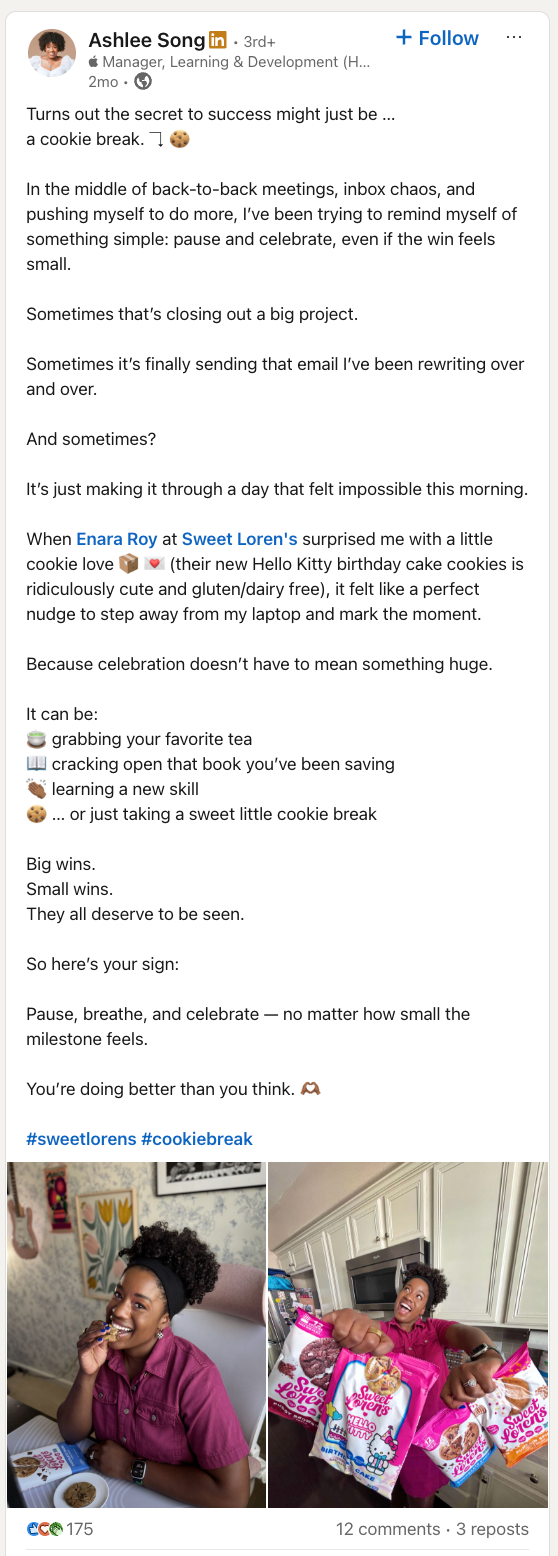
With the right tools, steady LinkedIn marketing becomes second nature
LinkedIn marketing isn’t about quick wins. Growth compounds when you show up regularly, share posts, engage with others, and stay part of meaningful conversations.
Over time, that steady activity builds visibility, brand awareness, and real connections that translate into lasting results.
Tools like Buffer make it easier to stay consistent. You can plan your LinkedIn content in advance, schedule posts across Linked (and other platforms you’re on), and track performance all in one place.
Sign up for Buffer today for free and stay on top of your LinkedIn marketing efforts.
Try Buffer for free
190,000+ creators, small businesses, and marketers use Buffer to grow their audiences every month.

